Sony Group DCRTRV50 Sony Handycam DCR-TRV50 User Manual DCR TRV40 50
Sony Corporation Sony Handycam DCR-TRV50 DCR TRV40 50
Contents
manual3

101
Editing
If your TV or VCR is a monaural type
Connect the yellow plug of the A/V connecting cable to the video output jack and the
white or the red plug to the audio output jack on the VCR or the TV. When the white
plug is connected, the left channel audio is recorded, and when the red plug is
connected, the right channel audio is recorded.
If your TV or VCR has an S video jack
Pictures can be reproduced more faithfully by using an S video cable (optional).
With this connection, you do not need to connect the yellow (video) plug of the A/V
connecting cable.
Connect an S video cable (optional) to the S video jacks of both your camcorder and the
TV or VCR.
This connection produces higher quality DV format pictures.
Note on the Remote Commander
Your camcorder works in the commander mode VTR 2. Commander modes 1, 2 and 3
are used to distinguish your camcorder from other Sony VCRs to avoid erroneous
remote control operation. If you use another Sony VCR in the commander mode VTR 2,
we recommend changing the commander mode or covering the sensor of the VCR with
black paper.
Recording video or TV programs
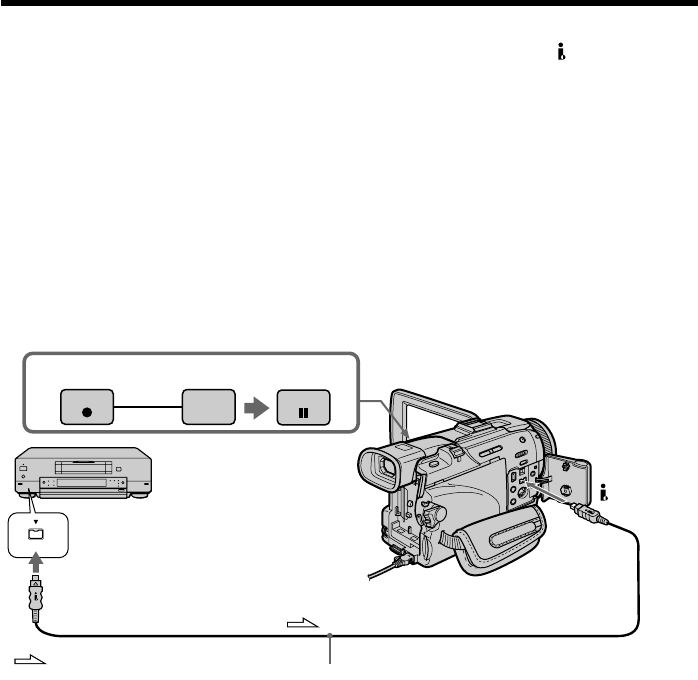
102
Recording video or TV programs
Using the i.LINK cable (DV connecting cable)
Simply connect the i.LINK cable (DV connecting cable) (optional) to DV IN/OUT jack
on your camcorder and to DV OUT on the DV products. With a digital-to-digital
connection, video and audio signals are transmitted in digital form for high-quality
editing.
(1)Insert a blank tape (or a tape you want to record over) into your camcorder,
and insert the recorded tape into the VCR.
(2)Set the POWER switch to VCR on your camcorder.
(3)Press z REC and the button on its right simultaneously on your camcorder,
then immediately press X on your camcorder.
(4)Press N on the VCR to start playback. The picture to be recorded appears on
the screen.
(5)Press X on your camcorder at the scene where you want to start recording
from.
When you have finished dubbing a tape
Press x on both your camcorder and the VCR.
Using the Remote Commander
In step 3, press z REC and MARK simultaneously, then immediately press X. In step 5,
press X at the scene where you want to start recording from.
DV
3
DV OUT
DV IN/OUT
REC PAUSE
i.LINK cable (DV connecting cable) (optional)
: Signal flow

103
Editing
You can connect one VCR only using the i.LINK cable (DV connecting cable).
During digital editing
The color of the display may be uneven. However, this does not affect the dubbed
picture.
If you record playback pause picture with the DV IN/OUT jack
The recorded picture becomes rough. When you play back the picture using your
camcorder, the picture may jitter.
Before recording
Make sure that the DV IN indicator appears on the screen or in the viewfinder. The DV
IN indicator may appear on both equipment.
Note on the Remote Commander
Your camcorder works in the commander mode VTR 2. Commander modes 1, 2 and 3
are used to distinguish your camcorder from other Sony VCRs to avoid erroneous
remote control operation. If you use another Sony VCR in the commander mode VTR 2,
we recommend changing the commander mode or covering the sensor of the VCR with
black paper.
Recording video or TV programs
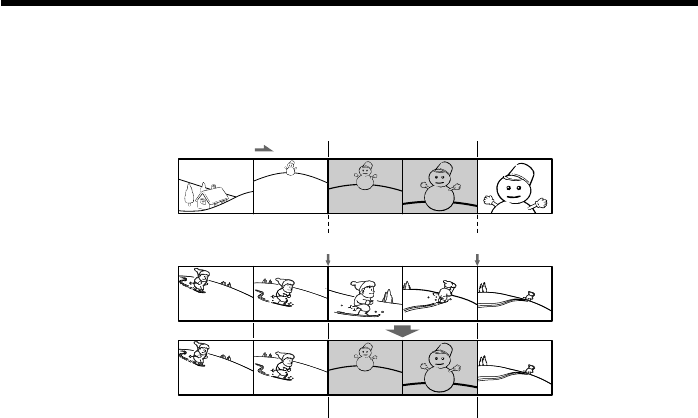
104
Inserting a scene from a VCR
– Insert Editing
You can insert a new scene from a VCR onto your originally recorded tape by
specifying the insert start and end points. Use the Remote Commander for this
operation. Connections are the same as on page 100 or 102.
Insert a cassette containing the desired scene to insert into the VCR.
[A]: A tape that contains the scene to be superimposed
[B]: A tape before editing
[C]: A tape after editing
(1)Set the POWER switch to VCR on your camcorder.
(2)On the connected VCR, locate just before the insert start point [a], then press
X to set the VCR to the playback pause.
(3)On your camcorder, locate the insert end point [c]. Then press X to set your
camcorder to the playback pause.
(4)Press ZERO SET MEMORY on the Remote Commander. The ZERO SET
MEMORY indicator flashes and the end point of the insert is stored in
memory. The tape counter shows “0:00:00.”
(5)On your camcorder, locate the insert start point [b] by pressing m, then press
z REC and the button on its right simultaneously.
(6)First press X on the VCR, and after a few seconds press X on your camcorder
to start inserting the new scene.
Inserting automatically stops near the zero point on the tape counter. Your
camcorder automatically returns to the recording pause.
[a]
[b][c]
[A]
[B]
[C]
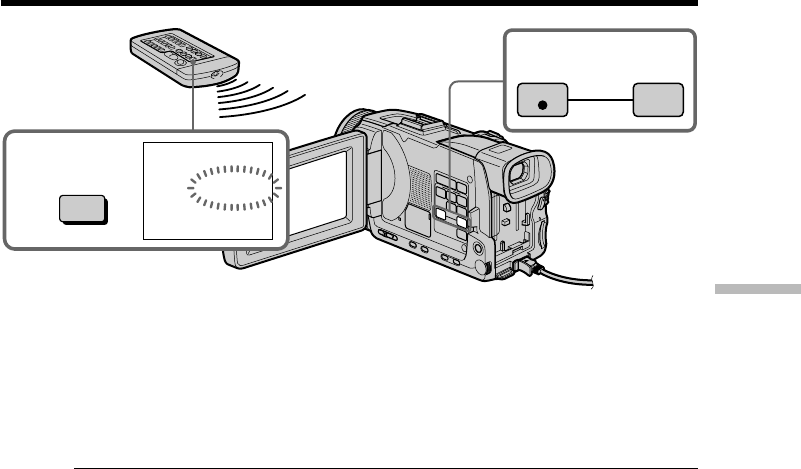
105
Editing
To change the insert end point
Press ZERO SET MEMORY again after step 5 to erase the ZERO SET MEMORY
indicator and begin from step 3.
Using the Remote Commander
In step 5, press z REC and MARK simultaneously, then immediately press X. In step 6,
press X at the scene where you want to start recording from.
Note
Pictures and sound recorded on the portion between the insert start and end points will
be erased when you insert the new scene.
If you insert scenes on the tape recorded on another camcorder (including other
DCR-TRV40/TRV50)
The pictures and sound may be distorted. We recommend that you insert scenes on a
tape recorded on your camcorder.
When the inserted picture is played back
Pictures and sound may be distorted at the end of the inserted portion. This is not a
malfunction.
Pictures and sound at the start point and the end point may be distorted in the LP
mode.
To insert a scene without setting the insert end point
Skip steps 3 and 4. Press x when you want to stop inserting.
If you press FN
The ZERO SET MEMORY indicator is not displayed.
Note on the Remote Commander
Your camcorder works in the commander mode VTR 2. Commander modes 1, 2 and 3
are used to distinguish your camcorder from other Sony VCRs to avoid erroneous
remote control operation. If you use another Sony VCR in the commander mode VTR 2,
we recommend changing the commander mode or covering the sensor of the VCR with
black paper.
Inserting a scene from a VCR – Insert Editing
4
0:00:00
ZERO SET
MEMORY
ZERO SET
MEMORY
5
REC
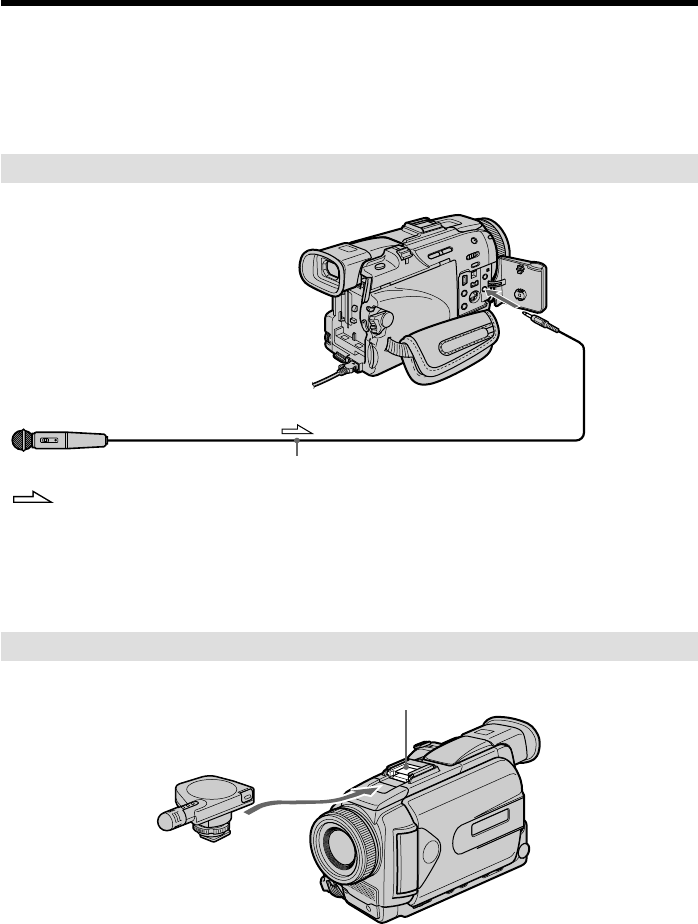
106
You can record audio to add to the original sound on a tape by connecting audio
equipment or a microphone. If you connect audio equipment, you can add sound to
your recorded tape already recorded in the 12-bit sound mode by specifying the start
and end points. The original sound will not be erased.
Use the Remote Commander for this operation.
Select one of the following connections to add audio.
Connecting the microphone with the MIC jack
You can check recorded picture and sound by connecting your camcorder to a TV with
the A/V connecting cable.
Recorded sound is not output from the speaker. Check the sound by using a TV or
headphones.
Connecting the microphone to the intelligent accessory shoe
Audio dubbing
Microphone (optional)
Intelligent accessory shoe
Microphone (optional)
: Signal flow
MIC
(PLUG IN POWER)
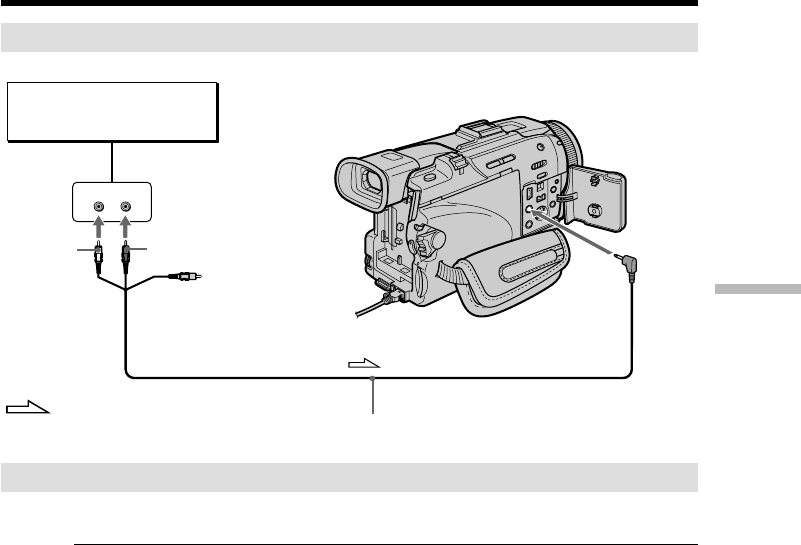
107
Editing
Connecting the A/V connecting cable to the AUDIO/VIDEO jack
Dubbing with the built-in microphone
No connection is necessary.
Note
When dubbing with the AUDIO/VIDEO jack or the built-in microphone, pictures are
not output through the S VIDEO jack or the AUDIO/VIDEO jack. Check the recorded
picture on the screen. You can check the recorded sound by using headphones.
If you make all the connections
The audio input to be recorded will take precedence over others in the following order:
•MIC (PLUG IN POWER) jack
•Intelligent accessory shoe
•AUDIO/VIDEO jack
•Built-in microphone
Audio dubbing
LINE OUT
LR
AUDIO
/
VIDEO
Audio equipment
Do not connect the
video (yellow) plug.
: Signal flow
AUDIO L AUDIO R
A/V connecting cable (supplied)
RedWhite
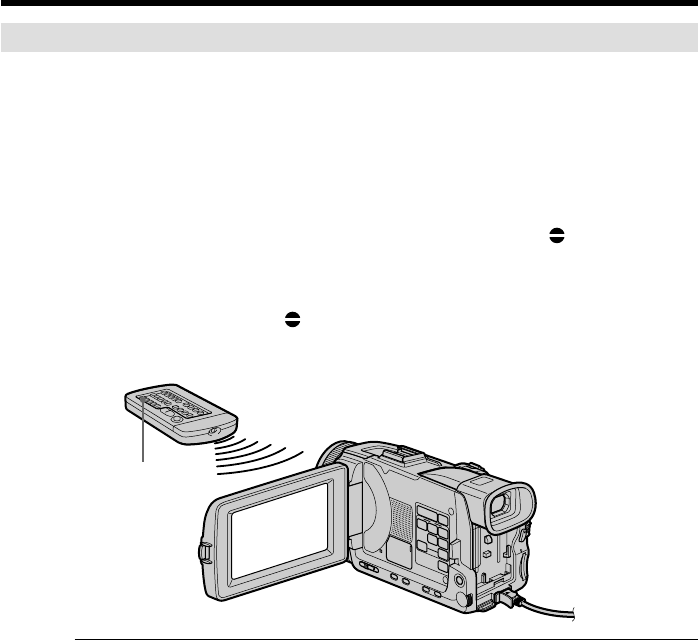
108
Adding audio on a recorded tape
Choose a connection described on the previous pages, and connect audio equipment or
microphone to your camcorder. Then follow the procedure below.
(1)Insert the recorded tape into your camcorder.
(2)Set the POWER switch to VCR on your camcorder.
(3)Locate the recording start point by pressing N. Then press X at the point
where you want to start recording to set your camcorder to the playback
pause.
(4)Press AUDIO DUB on the Remote Commander. The green X indicator
appears on screen.
(5)Press X and start playing back the audio you want to record at the same time.
The new sound is recorded in stereo 2 (ST2) during playback. While audio is
being recorded, the red appears on the screen.
(6)Press x at the point where you want to stop recording.
To add audio more precisely
Press ZERO SET MEMORY on the Remote Commander at the point where you want to
stop recording later in the playback.
Carry out from steps 3 to 5. Recording automatically stops at the point where ZERO
SET MEMORY was pressed.
Audio dubbing
AUDIO DUB
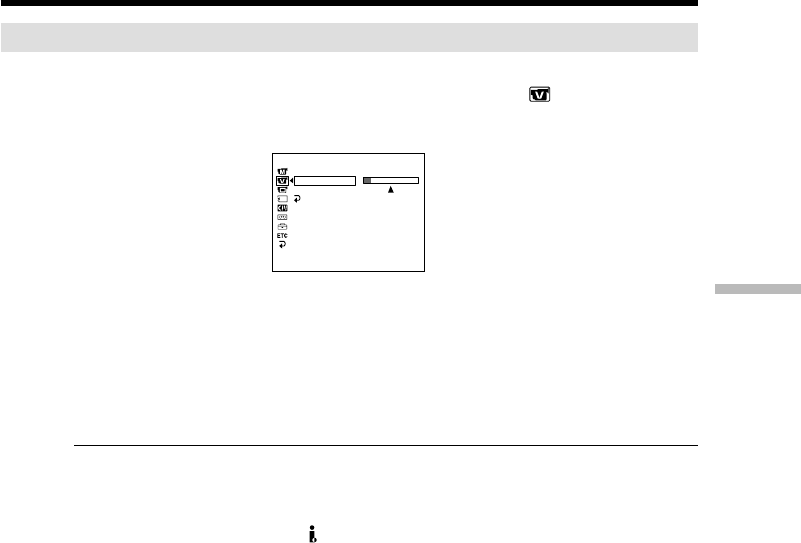
109
Editing
Audio dubbing
Monitoring the new recorded sound
(1)Play back the tape on which you added audio.
(2)Turn the SEL/PUSH EXEC dial to select AUDIO MIX in in the menu
settings, then press the dial.
(3)Turn the SEL/PUSH EXEC dial to adjust the balance between the original
sound (ST1) and the new sound (ST2), then press the dial.
Five minutes after you disconnect the power supply or remove the battery
pack, the AUDIO MIX setting returns to original sound (ST1) only. The default
setting is original sound only.
Notes
•New audio cannot be recorded on a tape already recorded in the 16-bit mode (32 kHz,
44.1 kHz or 48 kHz).
•New audio cannot be recorded on a tape already recorded in the LP mode.
•You cannot add audio with the DV IN/OUT jack.
•You cannot add audio on the blank portion of the tape.
If an i.LINK cable (DV connecting cable) (optional) is connected to your camcorder
You cannot add audio to a recorded tape.
We recommend that you add audio on a tape recorded with your camcorder
If you add audio on a tape recorded with another camcorder (including other
DCR-TRV40/TRV50), the sound quality may become worse.
If you set the write-protect tab of the cassette to lock
You cannot record on a tape. Slide the write-protect tab to release the write protection.
ST1 ST2
VCR SET
HiFi SOUND
AUDIO MIX
A/VcDV OUT
RETURN
[MENU] : END
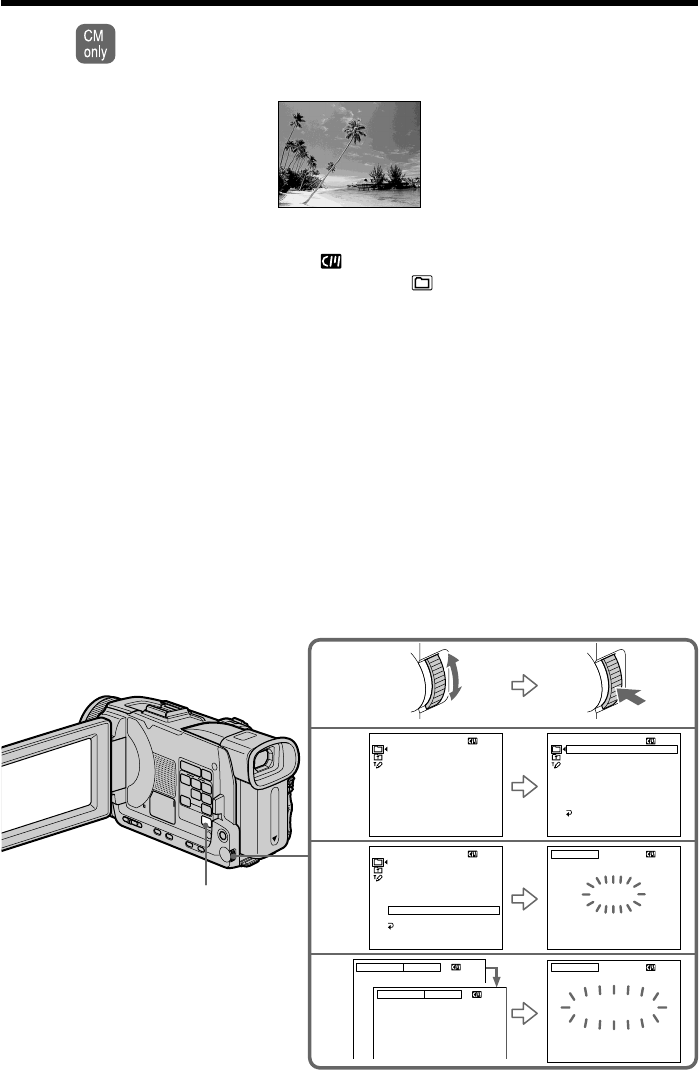
110
Superimposing a title
If you use a tape with cassette memory, you can superimpose the title. When
you play back the tape, the title is displayed for five seconds from the point
where you superimposed it.
(1)In the recording , recording standby, playback or playback pause, press
MENU, then select TITLE in with the SEL/PUSH EXEC dial (p. 205).
(2)Turn the SEL/PUSH EXEC dial to select , then press the dial.
(3)Turn the SEL/PUSH EXEC dial to select the desired title, then press the dial.
The title flashes.
(4)Change the color, size, or position, if necessary.
1Turn the SEL/PUSH EXEC dial to select COLOR, SIZE or POSITION, then
press the dial. The selected item appears.
2Turn the SEL/PUSH EXEC dial to select the desired item, then press the
dial.
3Repeat steps 1 and 2 until the title is laid out as desired.
(5)Press the SEL/PUSH EXEC dial again to complete the setting.
In the recording, playback or playback pause:
The TITLE SAVE indicator appears on the screen for five seconds and the title
is set.
In the standby:
The TITLE indicator appears. When you press START/STOP to start
recording, TITLE SAVE appears on the screen for five seconds, and the title is
set.
VACATION
2
3
4
VACATION
VACATION
VACATION
PRESET TITLE
HELLO!
HAPPY BIRTHDAY
HAPPY HOLIDAYS
CONGRATULATIONS!
OUR SWEET BABY
WEDDING
VACATION
THE END
[MENU] : END
PRESET TITLE
HELLO!
HAPPY BIRTHDAY
HAPPY HOLIDAYS
CONGRATULATIONS!
OUR SWEET BABY
WEDDING
VACATION
THE END
RETURN
[MENU] : END
PRESET TITLE
HELLO!
HAPPY BIRTHDAY
HAPPY HOLIDAYS
CONGRATULATIONS!
OUR SWEET BABY
WEDDING
VACATION
THE END
RETURN
[MENU] : END
TITLE
[EXEC] : SAVE [MENU] : END
TITLE
[EXEC] : SAVE [MENU] : END
SIZE SMALL
SIZE LARGE
MENU

111
Editing
Superimposing a title
If you set the write-protect tab of the cassette to lock
You cannot superimpose or erase the title. Slide the write-protect tab to release the write
protection.
To use a custom title
If you want to use a custom title, select in step 2.
If the tape has a blank portion
You cannot superimpose a title on the portion.
If the tape has a blank portion between recorded portions
Titles may not be displayed correctly.
Titles superimposed with your camcorder
•Titles are displayed by only the DV format video equipment with an index titler.
•The point you superimposed the title may be detected as an index signal when
searching a recording with other video equipment.
If the tape has too many index signals
You may not be able to superimpose a title because the cassette memory becomes full.
In this case, delete data you do not need.
To not display titles
Set TITLE DSPL to OFF in the menu settings (p. 205).
Title setting
•The title color changes as follows:
WHITE y YELLOW y VIOLET y RED y CYAN y GREEN y BLUE
•The title size changes as follows:
SMALL y LARGE
You cannot input 13 characters or more in LARGE size. If you input more than 12
characters, the title size returns to SMALL even if you select LARGE.
•If you select SMALL, you have nine choices for the title position.
If you select LARGE, you have eight choices for the title position.
One cassette can have up to about 20 titles, with each title comprising five
characters
However, if the cassette memory is full with date, photo and cassette label data, one
cassette can have only up to about 11 titles each comprising five characters.
Cassette memory capacity is as follows:
–six date data
–12 photo data
–one cassette label
If the “ FULL” mark appears
The cassette memory is full. Erase unwanted titles.
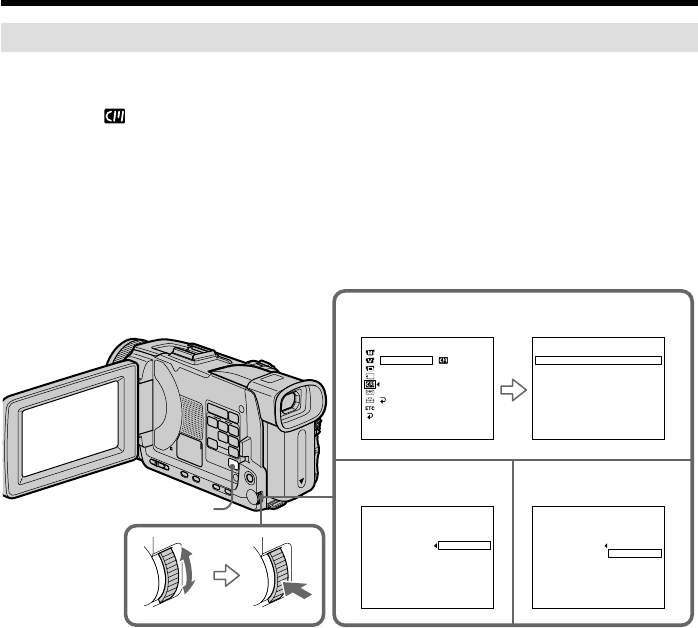
112
Erasing a title
(1)Set the POWER switch to CAMERA or VCR.
(2)Press MENU, then turn the SEL/PUSH EXEC dial to select TITLEERASE in
, then press the dial (p. 205).
(3)Turn the SEL/PUSH EXEC dial to select the title you want to erase, then press
the dial. ERASE OK ? indicator appears.
(4)Make sure that the title is the one you want to erase, and turn the SEL/PUSH
EXEC dial to select OK, then press the dial. OK changes to EXECUTE.
(5)Turn the SEL/PUSH EXEC dial to select EXECUTE, then press the dial.
The ERASING flashes on the screen. When the title is erased, the COMPLETE
is displayed.
To cancel erasing a title
Select RETURN in step 4 or 5.
Superimposing a title
2
34
CM SET
TITLE
TITLEERASE
TITLE DSPL
CM SEARCH
TAPE TITLE
ERASE ALL
RETURN
[MENU] : END
TITLE ERASE
1 HELLO!
2 CONGRATULATIONS!
3 HAPPY NEW YEAR!
4 PRESENT
5 GOOD MORNING
6 WEDDING
[MENU] : END
TITLE ERASE
4 PRESENT
ERASE OK?
[MENU] : END
TITLE ERASE
4 PRESENT
ERASE OK? RETURN
EXECUTE
RETURN
OK
[MENU] : END
MENU
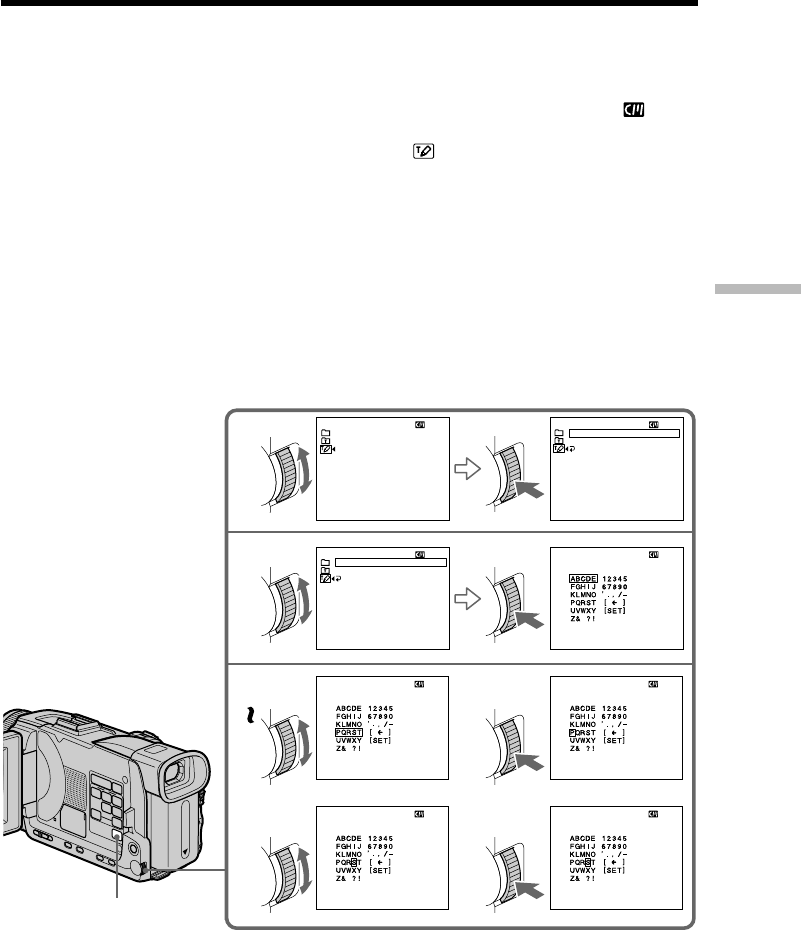
113
Editing
You can make up to two titles and store them in the memory of your camcorder. Each
title can have up to 20 characters.
(1)Set the POWER switch to CAMERA or VCR.
(2)Press MENU, then turn the SEL/PUSH EXEC dial to select TITLE in , then
press the dial (p. 205).
(3)Turn the SEL/PUSH EXEC dial to select , then press the dial.
(4)Turn the SEL/PUSH EXEC dial to select CUSTOM1 SET or CUSTOM2 SET,
then press the dial.
(5)Turn the SEL/PUSH EXEC dial to select the column of the desired character,
then press the dial.
(6)Turn the SEL/PUSH EXEC dial to select the desired character, then press the
dial.
(7)Repeat steps 5 and 6 until you have selected all characters and completed the
title.
(8)To finish making your own titles, turn the SEL/PUSH EXEC dial to select
[SET], then press the dial.
Making your own titles
3
4
5
7
12
34
TITLE SET
CUSTOM1 SET
CUSTOM2 SET
[MENU] : END
TITLE SET
CUSTOM1 SET
CUSTOM2 SET
RETURN
[MENU] : END
TITLE SET
–––––––––––––––––––
–
[MENU] : END
TITLE SET
––––––––––––––––––––
[MENU] : END
[MENU] : END
TITLE SET
S–––––––––––––––––––
[MENU] : END
TITLE SET
CUSTOM1 SET
CUSTOM2 SET
RETURN
[MENU] : END
[MENU] : END
TITLE SET
–––––––––––––––––––
–
TITLE SET
––––––––––––––––––––
MENU

114
Making your own titles
To change a title you have stored
In step 4, select CUSTOM1 SET or CUSTOM2 SET, depending on which title you want
to change, then press the SEL/PUSH EXEC dial. Turn the SEL/PUSH EXEC dial to
select [C], then press the dial to delete the title. The last character is erased. Enter the
new title as desired.
If you take five minutes or longer to enter characters in the standby while a
cassette is in your camcorder
The power automatically goes off. The characters you have entered remain stored in
memory. Set the POWER switch to OFF (CHG) once and then to CAMERA again, then
proceed from step 1.
We recommend setting the POWER switch to VCR or removing the cassette so that
your camcorder does not automatically turn off while you are entering title characters.
To delete the title
Select [C]. The last character is erased.
To enter a space
Select [ Z& ? ! ], then select the blank part.
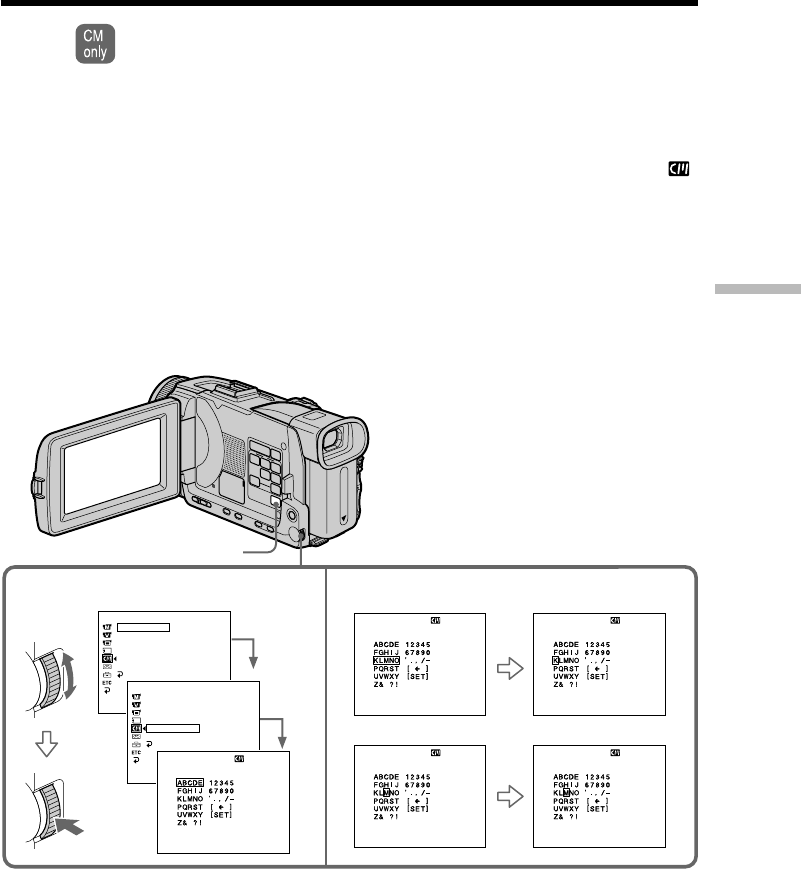
115
Editing
If you use a cassette with cassette memory, you can label a cassette. Labels can
consist of up to 10 characters and is stored in cassette memory. When you insert
the labeled cassette and when the POWER switch is set to CAMERA or VCR, the
label is displayed for about five seconds.
(1)Insert the cassette you want to label.
(2)Set the POWER switch to CAMERA or VCR.
(3)Press MENU, then turn the SEL/PUSH EXEC dial to select TAPE TITLE in ,
then press the dial (p. 205). Tape title display appears.
(4)Turn the SEL/PUSH EXEC dial to select the column of the desired character,
then press the dial.
(5)Turn the SEL/PUSH EXEC dial to select the desired character, then press the
dial.
(6)Repeat steps 4 and 5 until you finish the label.
(7)Turn the SEL/PUSH EXEC dial to select [SET], then press the dial.
The label is stored in memory.
Labeling a cassette
34~6
[MENU] : END
TAPE TITLE
––––––––––
[MENU] : END
TAPE TITLE
––––––––––
[MENU] : END
TAPE TITLE
––––––––––
[MENU] : END
TAPE TITLE
M
–––––––––
[MENU] : END
CM SET
TITLE
TITLEERASE
TITLE DSPL
CM SEARCH
TAPE TITLE
ERASE ALL
RETURN
READY
––––––––––
[MENU] : END
CM SET
TITLE
TITLEERASE
TITLE DSPL
CM SEARCH
TAPE TITLE
ERASE ALL
RETURN
[MENU] : END
TAPE TITLE
––––––––––
MENU
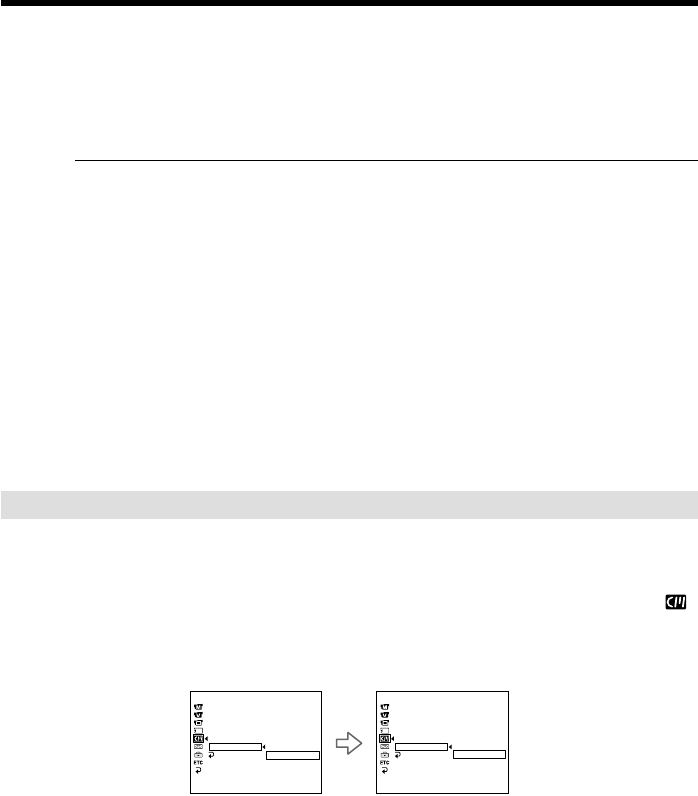
116
To erase the label you have made
In step 4 turn the SEL/PUSH EXEC dial to select [C], then press the dial. The last
character is erased.
To change the label you have made
Insert the cassette to change the label, and operate in the same way to make a new label.
If you set the write-protect tab of the cassette to lock
You cannot label the tape. Slide the write-protect tab to release the write protection.
If the tape has too many index signal
You may not be able to label a cassette because the cassette memory becomes full. In
this case, delete data you do not need.
If you have superimposed titles in the cassette
When the label is displayed, up to four titles also appear.
When the “-----” indicator has fewer than 10 spaces
The cassette memory is full.
The “-----” indicates the number of characters you can select for the label.
To enter a space
Select [ Z& ? ! ], then select the blank part.
Erasing all the data in cassette memory
You can erase all the data in cassette memory at once.
(1)Set the POWER switch to CAMERA or VCR.
(2)Press MENU, then turn the SEL/PUSH EXEC dial to select ERASE ALL in ,
then press the dial (p. 205).
(3)Turn the SEL/PUSH EXEC dial to select OK, then press the dial. OK changes
to EXECUTE.
(4)Turn the SEL/PUSH EXEC dial to select EXECUTE, then press the dial.
ERASING flashes on the screen. When all the data is erased, COMPLETE is
displayed.
To cancel deleting
Select RETURN with the SEL/PUSH EXEC dial in step 3 or 4.
Labeling a cassette
[MENU] : END
CM SET
TITLE
TITLEERASE
TITLE DSPL
CM SEARCH
TAPE TITLE
ERASE ALL
RETURN RETURN
OK
[MENU] : END
CM SET
TITLE
TITLEERASE
TITLE DSPL
CM SEARCH
TAPE TITLE
ERASE ALL
RETURN RETURN
EXECUTE
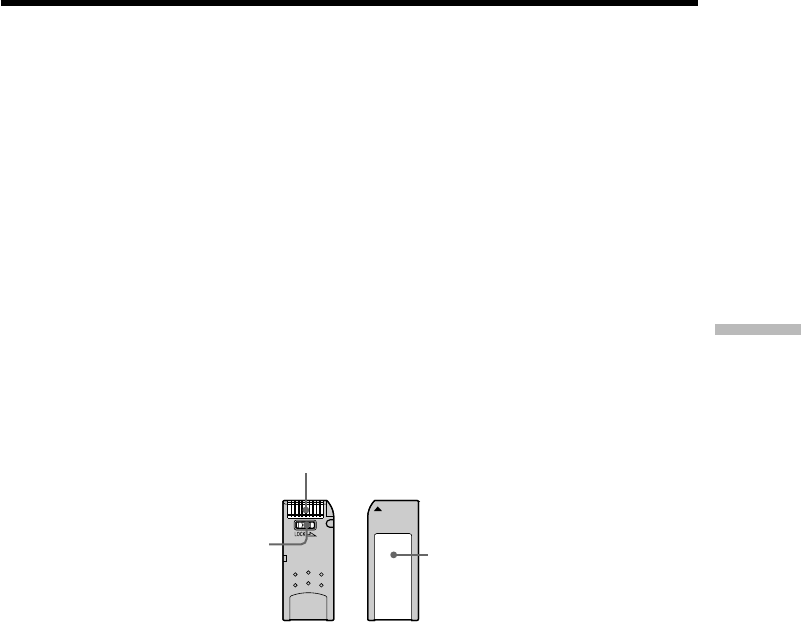
117
“Memory Stick” Operations
You can record and play back images on a “Memory Stick” supplied with your
camcorder. You can easily play back, record or delete images. You can exchange image
data with other equipment such as your computer etc., using the USB cable for
“Memory Stick” supplied with your camcorder.
On file format
Still image (JPEG)
Your camcorder compresses image data in JPEG format (extension .jpg).
Moving picture (MPEG)
Your camcorder compresses picture data in MPEG format (extension .mpg).
Typical image data file name
Still image
100-0001: This file name appears on the screen of your camcorder.
Dsc00001.jpg: This file name appears on the display of your computer.
Moving picture
MOV00001: This file name appears on the screen of your camcorder.
Mov00001.mpg: This file name appears on the display of your computer.
Using a “Memory Stick”
•You cannot record or erase images when the write-protect tab on the “Memory Stick”
is set to LOCK.
•The position and shape of the write-protect tab may be different depending on the
model.
•We recommend backing up important data on the hard disk of your computer.
•Image data may be damaged in the following cases:
–If you eject the “Memory Stick” or turn the power off during reading or writing.
–If you use “Memory Stick”s near static electricity or magnetic fields.
•Prevent metallic objects or your finger from coming into contact with the metal parts
of the terminal.
•Stick the label at the labeling position.
•Do not bend, drop or apply strong shock to “Memory Stick”s.
•Do not disassemble or modify “Memory Stick”s.
•Do not let “Memory Stick”s get wet.
•Do not use or keep “Memory Stick”s in locations that are:
–Extremely hot such as in a car parked in the sun or under the scorching sun.
–Under direct sunlight
–Very humid or subject to corrosive gases
•When you carry or store a “Memory Stick,” put it in its case.
— “Memory Stick” Operations —
Using a “Memory Stick” – Introduction
Write-protect tab Labeling position
Terminal

118
“Memory Stick”s formatted on computer
“Memory Stick”s formatted on Windows OS or Macintosh computers are not
guaranteed compatible with your camcorder.
Notes on image data compatibility
•Image data files recorded on “Memory Stick”s by your camcorder conform with the
Design Rules for Camera File Systems universal standard established by the JEITA
(Japan Electronics and Information Technology Industries Association). You cannot
play back on your camcorder still images recorded on other equipment (DCR-
TRV890E/TRV900/TRV900E or DSC-D700/D770) that does not conform with this
universal standard. (These models are not sold in some areas.)
•If you cannot use the “Memory Stick” that is used with other equipment, format it
with this camcorder (p. 204). However, formatting erases all information on the
“Memory Stick.”
•“Memory Stick” and are trademarks of Sony Corporation.
•All other product names mentioned here may be the trademarks or registered
trademarks of their respective companies.
“TM” and “®” are not mentioned in each case in this manual.
Using a “Memory Stick” – Introduction
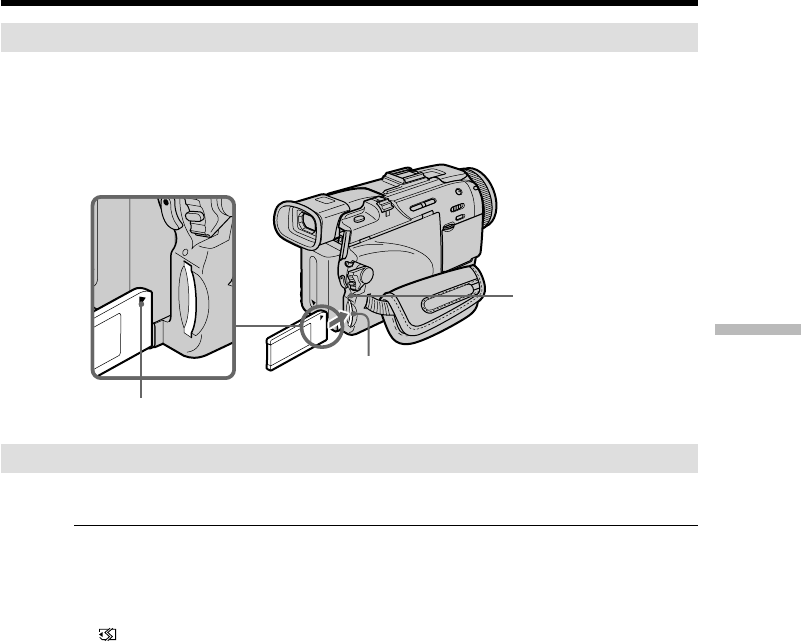
119
“Memory Stick” Operations
Inserting a “Memory Stick”
Insert a “Memory Stick” in the “Memory Stick” slot as far as it can go with the B mark
facing as illustrated.
Ejecting a “Memory Stick”
Press the “Memory Stick” once lightly.
While the access lamp is lit or flashing
Do not shake or knock your camcorder because your camcorder is reading the data
from the “Memory Stick” or recording the data on the “Memory Stick.” Do not turn the
power off, eject a “Memory Stick.” Otherwise, image data may become damaged.
If “ MEMORY STICK ERROR” is displayed
Reinsert “Memory Stick” a few times. The “Memory Stick” may be damaged if the
indicator is still displayed. If this occurs, use another “Memory Stick.”
“Memory Stick” slot
B mark
Access lamp
Using a “Memory Stick” – Introduction
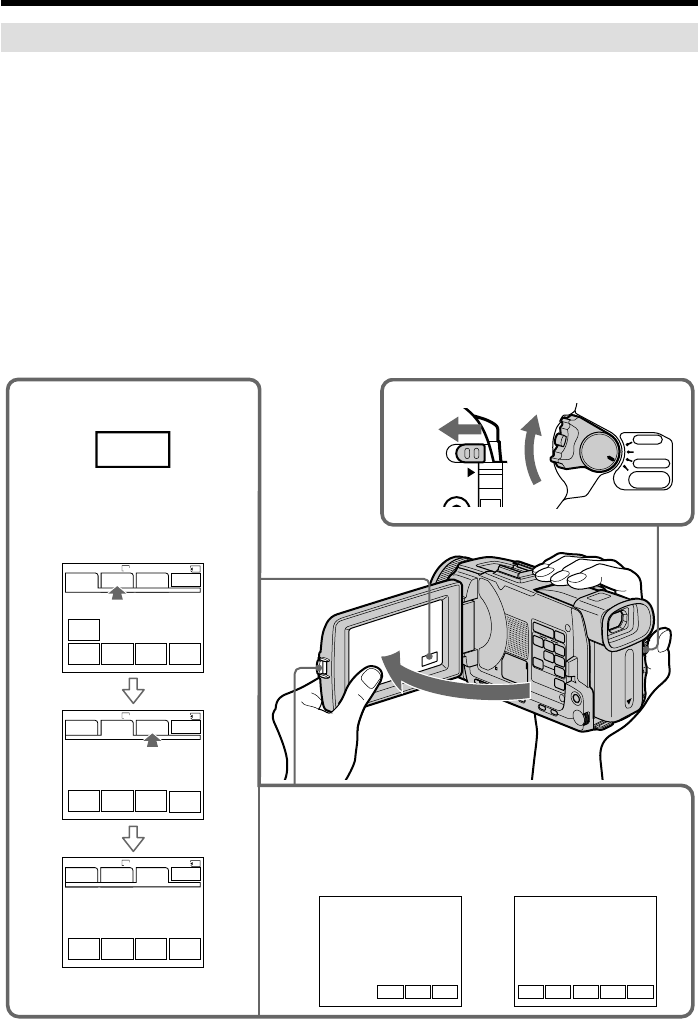
120
Using a “Memory Stick” – Introduction
Using a touch panel
Most operation buttons for use of “Memory Stick”s are displayed on the LCD screen.
Touch the LCD screen directly with your finger or the supplied stylus (DCR-TRV50
only) to operate each function.
(1)Set the POWER switch to MEMORY/NETWORK (DCR-TRV50 only). Make
sure that the LOCK switch is set to the left (unlock) position.
(2)Press OPEN to open the LCD panel. Operation buttons appear on the LCD
screen. You can switch the memory playback/memory camera by pressing
PLAY/CAM.
(3)Press FN. Operation buttons appear on the LCD screen.
(4)Press PAGE2 to go to PAGE2. Operation buttons appear on the LCD screen.
(5)Press PAGE3 to go to PAGE3. Operation buttons appear on the LCD screen.
(6)Press a desired operation item.
Refer to relevant pages for each function.
FN 1
3~6
2
FNINDEXPLAY FNINDEXCAM
SPOT
FOCUS PLAY INDEX SPOT
METER
SELF
TIMER
MEM
MIX
9PIC
PRINT
LCD
BRT PLAY INDEX
PLAY INDEX
+–
PAGE1 PAGE2 PAGE3
PAGE1 PAGE2 PAGE3
SLIDE
SHOW
PAGE1 PAGE2 PAGE3
EXIT
EXIT
EXIT
1360 1/12SFN
1360 1/12SFN
1360 1/12SFN
VCR
MEMORY/
NETWORK
CAMERA
OFF(CHG)
POWER
LOCK
In the memory camera
In the memory
camera In the memory
playback (still
image)
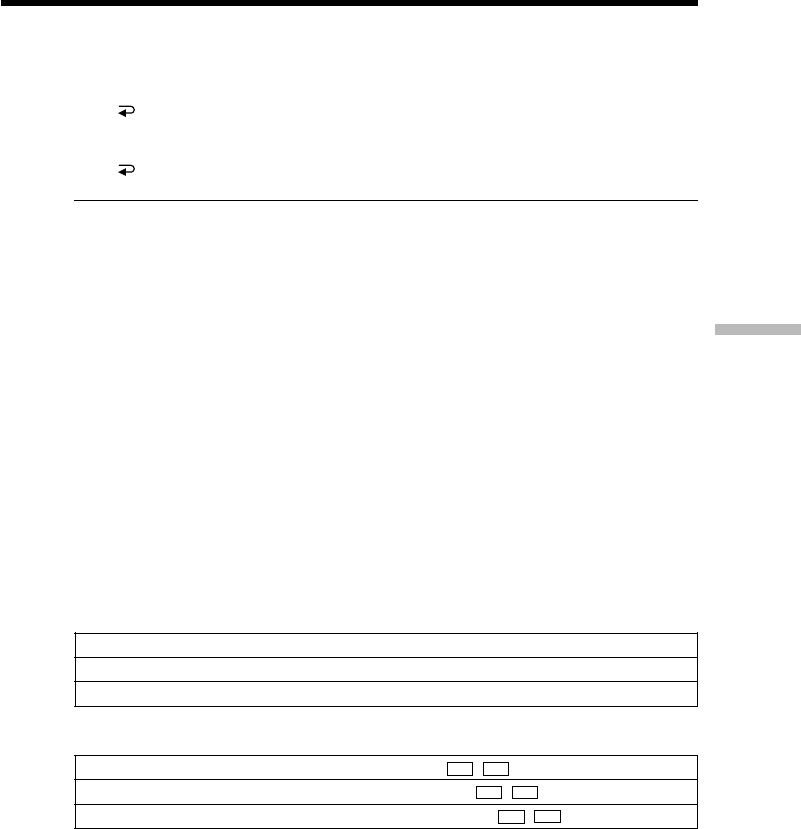
121
“Memory Stick” Operations
To return to FN
Press EXIT.
To execute settings
Press OK.
To cancel settings
Press OFF to return to PAGE1/PAGE2/PAGE3.
Notes
•When using the touch panel, press operation buttons with your thumb supporting the
LCD screen from the back side of it or press those buttons lightly with your index
finger.
•Do not press the LCD screen with sharp objects other than the supplied stylus. (DCR-
TRV50 only)
•Do not press the LCD screen too hard.
•Do not touch the LCD screen with wet hands.
•If FN is not on the LCD screen, touch the LCD screen lightly to make it appear. You
can control the display with DISPLAY/TOUCH PANEL on your camcorder.
•When operation buttons do not work even if you press them, an adjustment is
required (CALIBRATION) (p. 230).
•When the LCD screen gets dirty, clean it with the supplied cleaning cloth.
When executing each item
The green bar appears above the item.
If the items are not available
The color of the items changes to gray.
Press FN to display the following buttons:
In the memory camera
PAGE1 SELFTIMER, SPOT FOCUS, PLAY, INDEX, SPOT METER
PAGE2 LCD BRT, PLAY, INDEX, MEM MIX
PAGE3 SLIDE SHOW, PLAY, INDEX, 9PIC PRINT
In the memory playback
PAGE1 PB ZOOM, CAM, INDEX, DELETE,
+
,
–
PAGE2 LCD BRT, CAM, INDEX, DATA CODE,
+
,
–
PAGE3 SLIDE SHOW, CAM, INDEX, 9PIC PRINT,
+
,
–
Using a “Memory Stick” – Introduction
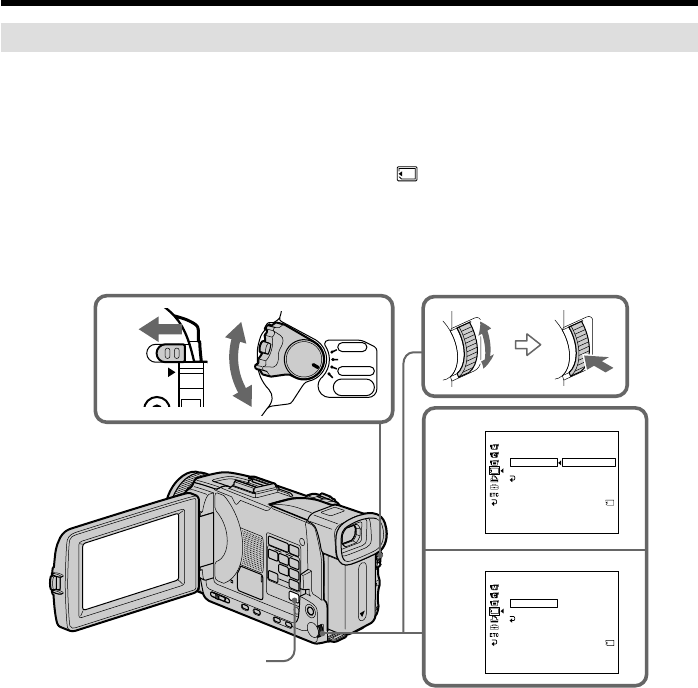
122
Selecting the still image quality
You can select the image quality in still image recording. The default setting is SUPER
FINE.
(1)Set the POWER switch to MEMORY/NETWORK (DCR-TRV50 only) or VCR.
Make sure that the LOCK switch is set to the left (unlock) position.
(2)Press MENU, then select STILL SET in with the SEL/PUSH EXEC dial
(p. 203).
(3)Turn the SEL/PUSH EXEC dial to select QUALITY , then press the dial.
(4)Turn the SEL/PUSH EXEC dial to select the desired image quality , then press
the dial.
Using a “Memory Stick” – Introduction
1
3
4
VCR
MEMORY/
NETWORK
CAMERA
OFF(CHG)
POWER
LOCK
MEMORY SET
STILL SET
BURST
QUALITY
IMAGESIZE
RETURN
SUPER FINE
FINE
STANDARD
[MENU] : END
REMAIN
12
MEMORY SET
STILL SET
BURST
QUALITY
IMAGESIZE
RETURN
STANDARD
[MENU] : END
REMAIN
36
MENU

123
“Memory Stick” Operations
Image quality settings
Setting Meaning
SUPER FINE (SFN) This is the highest image quality in your camcorder.
The number of still images you can record is less than
in FINE mode. Super fine images are compressed to
about 1/3.
FINE (FINE) Use this mode when you want to record high quality
images. Fine images are compressed to about 1/6.
STANDARD (STD) This is the standard image quality in your camcorder.
Standard images are compressed to about 1/10.
Note
In some cases, changing the image quality may not affect the image quality, depending
on the type of images you are shooting.
Differences in image quality
Recorded images are compressed in JPEG format before being stored in memory. The
memory capacity allotted to each image varies depending on the selected image quality
and image size. Details are shown in the table below. (You can select 1360 × 1020 or 640
× 480 image size in the menu settings.)
1360 × 1020 image size
Image quality Memory capacity
SUPER FINE About 900 KB
FINE About 450 KB
STANDARD About 300 KB
640 × 480 image size
Image quality Memory capacity
SUPER FINE About 190 KB
FINE About 100 KB
STANDARD About 60 KB
Image quality indicator
The image quality indicator is not displayed during playback.
When you select image quality
The number of images you can shoot in the currently selected image quality appears on
the screen.
Using a “Memory Stick” – Introduction
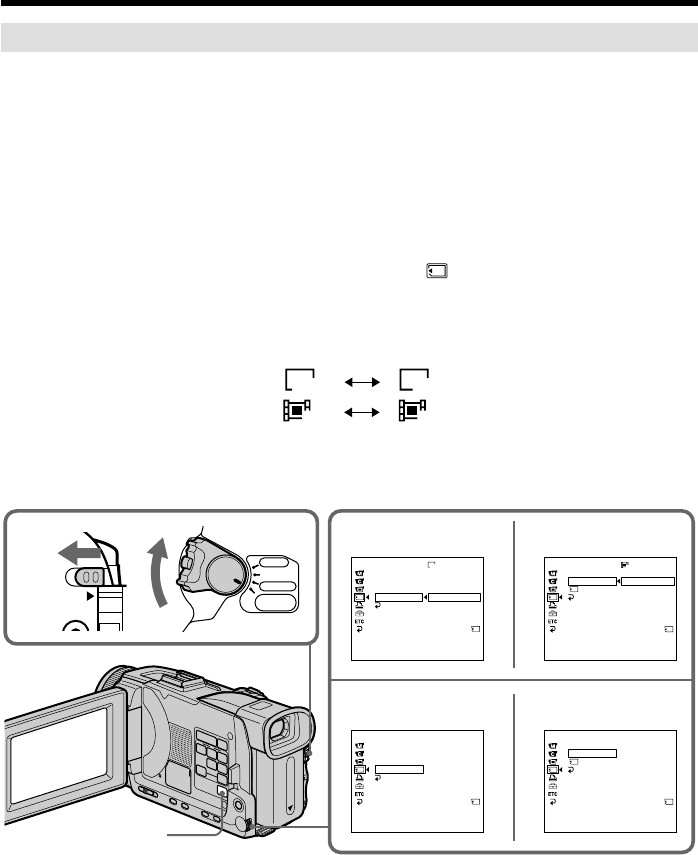
124
Selecting the image size
You can select either of two image sizes
Still images: 1360 × 1020 or 640 × 480. (When the POWER switch is set to CAMERA
or VCR, the image size is automatically set to 640 × 480.)
The default setting is 1360 × 1020.
Moving pictures: 320 × 240 or 160 × 112
The default setting is 320 × 240.
(1)Set the POWER switch to MEMORY/NETWORK (DCR-TRV50 only). Make
sure that the LOCK switch is set to the left (unlock) position.
(2)Press MENU, then turn the SEL/PUSH EXEC dial to select STILL SET (still
image) or MOVIE SET (moving picture) in , then press the dial (p. 203).
(3)Turn the SEL/PUSH EXEC dial to select IMAGESIZE, then press the dial.
(4)Turn the SEL/PUSH EXEC dial to select the desired image size, then press the
dial.
The indicator changes as follows:
Still images:
1360 640
Moving pictures:
320 160
Using a “Memory Stick” – Introduction
3
4
1
VCR
MEMORY/
NETWORK
CAMERA
OFF(CHG)
POWER
LOCK
320
1360
MEMORY SET
STILL SET
BURST
QUALITY
IMAGESIZE
RETURN 1360 × 1020
640 × 480
[MENU] : END
MEMORY SET
MOVIE SET
IMAGESIZE
REMAIN
RETURN
320 × 240
160 × 112
[MENU] : END
REMAIN
40sec
MEMORY SET
STILL SET
BURST
QUALITY
IMAGESIZE
RETURN 640 × 480
[MENU] : END
REMAIN
60
REMAIN
12
MEMORY SET
MOVIE SET
IMAGESIZE
REMAIN
RETURN
160 × 112
[MENU] : END
REMAIN
2min
STILL SET MOVIE SET
STILL SET MOVIE SET
MENU
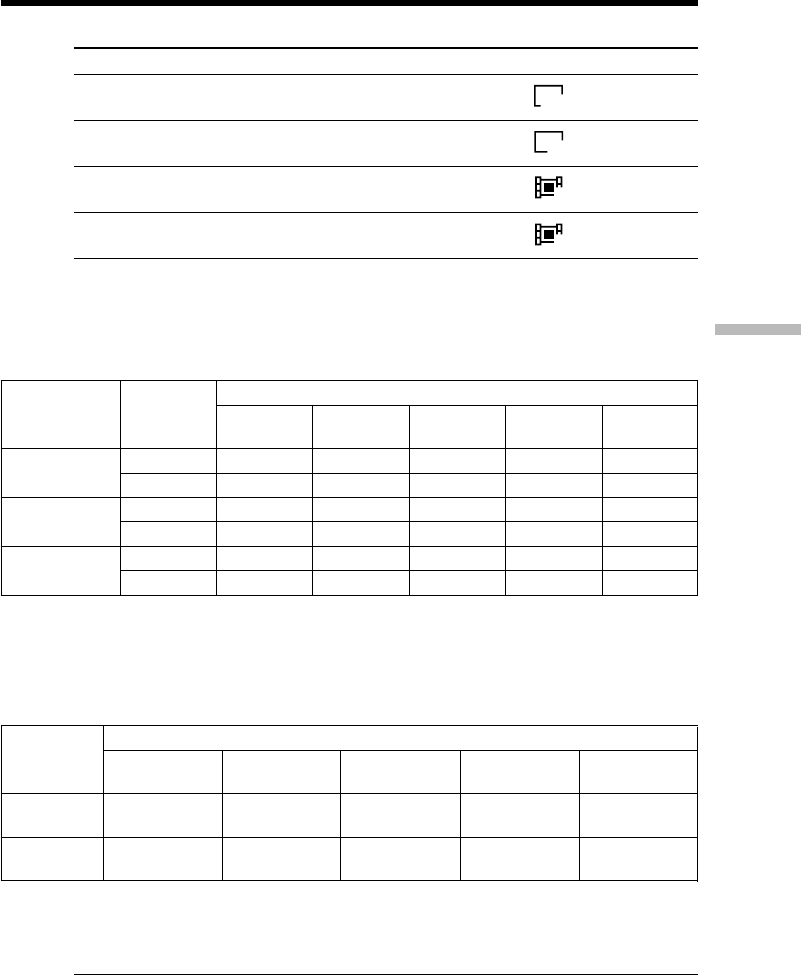
125
“Memory Stick” Operations
Using a “Memory Stick” – Introduction
Image size settings
Setting Meaning Indicator
1360 × 1020 Records 1360 × 1020 still images.
1360
640 × 480 Records 640 × 480 still images.
640
320 × 240 Records 320 × 240 moving pictures.
320
160 × 112 Records 160 × 112 moving pictures.
160
Approximate number of still images you can record on a
“Memory Stick”
The number of images you can record varies depending on which image quality and
image size you select and the complexity of the subject.
Approximate time of moving pictures you can record on a
“Memory Stick”
The time of moving pictures you can record varies depending on which image size you
select and the complexity of the subject.
The table above shows approximate number and times of still images and moving
pictures you can record on a “Memory Stick” formatted by your camcorder.
Note
When still images recorded on your camcorder in 1360 × 1020 size are played back on
other equipment that does not support 1360 × 1020 size, the full image may not appear.
Type of “Memory Stick”s
Image size 8MB 16MB 32MB 64MB 128MB
(supplied) (optional) (optional) (optional) (optional)
320 × 240 1 min. 2 min. 5 min. 10 min. 21 min.
20 sec. 40 sec. 20 sec. 40 sec. 20 sec.
160 × 112 5 min. 10 min. 21 min. 42 min. 85 min.
20 sec. 40 sec. 20 sec. 40 sec. 20 sec.
Type of “Memory Stick”s
Image quality Image size 8MB 16MB 32MB 64MB 128MB
(supplied) (optional) (optional) (optional) (optional)
SUPER FINE 1360 × 1020 8 images 17 images 35 images 71 images 140 images
640 × 480 40 images 80 images 160 images 325 images 650 images
FINE 1360 × 1020 17 images 34 images 69 images 140 images 280 images
640 × 480 80 images 160 images 325 images 650 images 1310 images
STANDARD 1360 × 1020 25 images 50 images 100 images 205 images 415 images
640 × 480 120 images 240 images 485 images 980 images 1970 images
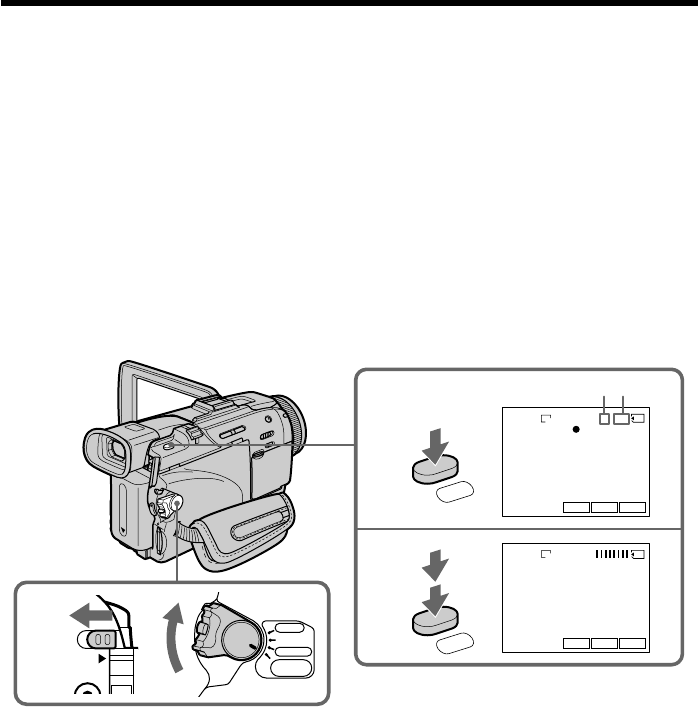
126
You can record still images on “Memory Stick”s.
Before operation
Insert a “Memory Stick” into your camcorder.
(1)Set the POWER switch to MEMORY/NETWORK (DCR-TRV50 only). Make
sure that the LOCK switch is set to the left (unlock) position.
(2)Press PHOTO lightly. The green z mark stops flashing, then lights up. The
brightness of the image and focus are adjusted, being targeted for the middle
of the image and are fixed. Recording does not start yet.
(3)Press PHOTO deeper.
The still image will be displayed after the shutter sounds.
Recording is complete when the bar scroll indicator disappears.
The image when you pressed PHOTO deeper will be recorded on the
“Memory Stick.”
You can record still images on “Memory Stick”s in the tape
recording or tape recording standby
For the details, see page 47.
Recording still images on “Memory
Stick”s – Memory Photo recording
3
2
1 / 12
SFN
1360
SFN
1360
FN
INDEXPLAY
FN
INDEXPLAY
PHOTO
PHOTO
1
LOCK
VCR
MEMORY/
NETWORK
CAMERA
OFF(CHG)
POWER
[a][b]
[a]: Number of recorded images
[b]: Approximate number of images that can
be recorded on the “Memory Stick”

127
“Memory Stick” Operations
Recording still images on “Memory Stick”s
– Memory Photo recording
When the POWER switch is set to MEMORY/NETWORK (DCR-TRV50 only)
The following functions do not work:
–Wide mode
–Digital zoom
–SteadyShot
–Super NightShot
–Color Slow Shutter
–Fader
–Picture effect
–Digital effect
–Title
–Sports lesson of PROGRAM AE (The indicator flashes.)
While you are recording a still image
You can neither turn off the power nor press PHOTO.
When you press PHOTO on the Remote Commander
Your camcorder immediately records the image that is on the screen when you press
the button.
When you press PHOTO lightly in step 2
The image momentarily flickers. This is not a malfunction.
Recording data
The recording data (date/time or various settings when recorded) are not displayed
while recording. However, they are recorded automatically onto the “Memory Stick.”
To display the recording data, press DATA CODE during playback. You can also use
the Remote Commander for this opration (p. 42).
When the POWER switch is set to MEMORY/NETWORK (DCR-TRV50 only)
The angle of view is slightly larger compared with the angle of view when the POWER
switch is set to CAMERA.
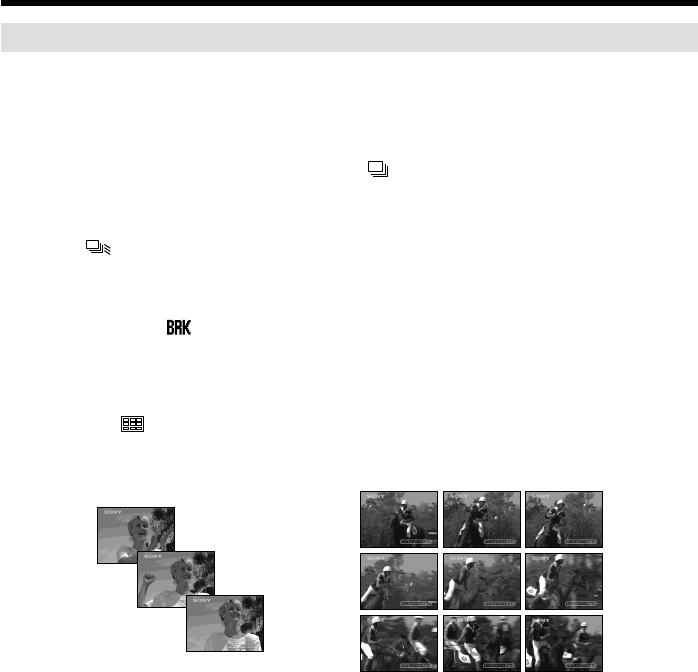
128
Recording still images on “Memory Stick”s
– Memory Photo recording
Recording images continuously
You can record still images continuously. Before recording, select one of the four modes
described below in the menu settings.
NORMAL [a]
Your camcorder shoots up to three still images in 1360 × 1020 size or nine still images in
640 × 480 size at about 0.5 sec intervals. ( )
HIGH SPEED [a]
Your camcorder shoots up to 16 still images in 640 × 480 size at about 0.07 sec intervals.
( )
EXP BRKTG (Exposure Bracketing)
Your camcorder automatically shoots three images at about 0.5 sec intervals at different
exposures. ( )
MULTI SCRN (Multi Screen) [b]
Your camcorder shoots nine still images at about 0.4 sec intervals and displays the
images on a single page divided into nine boxes. Still images are recorded in 640 × 480
size. ( )
[a] [b]
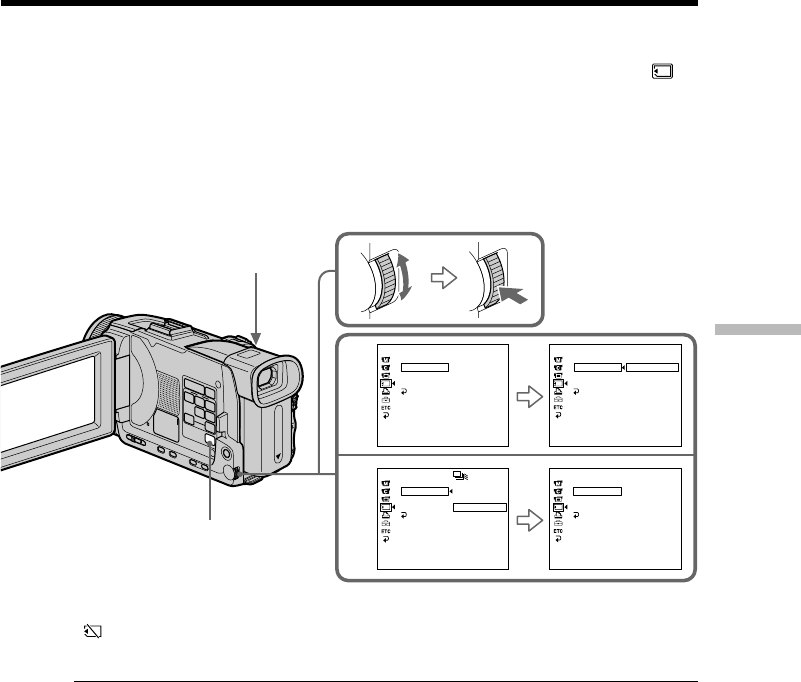
129
“Memory Stick” Operations
(1)Set the POWER switch to MEMORY/NETWORK (DCR-TRV50 only). Make
sure that the LOCK switch is set to the left (unlock) position.
(2)Press MENU, then turn the SEL/PUSH EXEC dial to select STILL SET in ,
then press the dial (p. 203).
(3)Turn the SEL/PUSH EXEC dial to select BURST, then press the dial.
(4)Turn the SEL/PUSH EXEC dial to select the desired setting, then press the
dial.
(5)Press MENU to make the menu setting disappear.
(6)Press PHOTO deeper.
If the capacity of the “Memory Stick” becomes full
” FULL” appears on the screen, and you cannot record a still image on this “Memory
Stick.”
The number of still images in continuous shooting
The number of still images you can shoot continuously varies depending on the image
size and the capacity of the “Memory Stick.”
During recording still images continuously
The flash does not work.
When shooting with the self-timer or the Remote Commander
Your camcorder automatically records up to the maximum recordable number of still
images.
Recording still images on “Memory Stick”s
– Memory Photo recording
3
4
MEMORY SET
STILL SET
BURST
QUALITY
IMAGESIZE
RETURN
OFF
[MENU] : END
MEMORY SET
STILL SET
BURST
QUALITY
IMAGESIZE
RETURN
OFF
NORMAL
HIGH SPEED
EXP BRKTG
MULTI SCRN
[MENU] : END
MEMORY SET
STILL SET
BURST
QUALITY
IMAGESIZE
RETURN
HIGH SPEED
[MENU] : END
MEMORY SET
STILL SET
BURST
QUALITY
IMAGESIZE
RETURN
OFF
NORMAL
HIGH SPEED
EXP BRKTG
MULTI SCRN
[MENU] : END
PHOTO
MENU
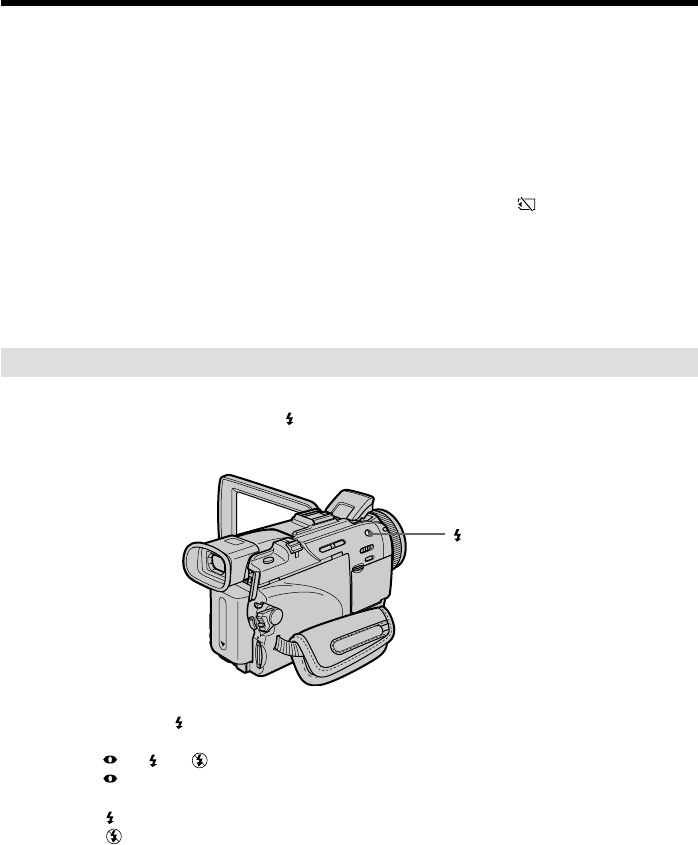
130
When selecting NORMAL or HIGH SPEED
Recording continues up to the maximum number of still images during pressing
PHOTO deeper. Release PHOTO to stop recording.
When selecting HIGH SPEED
Flickering or changes in color may occur. Also, your camcorder prevents focusing on
near objects.
If there is space remaining on the “Memory Stick” for less than three photos
You cannot carry out the exposure bracketing (EXP BRKTG). “ FULL” is displayed
when you press PHOTO.
The effect of exposure bracketing (EXP BRKTG)
The effect may not appear clearly on the LCD screen.
Checking images on a TV monitor or computer display for the expected effect is
recommended.
Recording images with the flash
The flash automatically pops up to strobe. The default setting is auto (no indicator). To
change the flash mode, press (flash) repeatedly until the flash mode indicator
appears on the screen.
Each press of (flash) changes the indicator as follows:
t t t No indicator
Auto red-eye reduction: The flash fires before recording to reduce the red-eye
phenomenon.
Forced flash: The flash fires regardless of the surrounding brightness.
No flash: The flash does not fire.
The flash is automatically adjusted to the appropriate brightness. You can also change
FLASH LVL to the desired brightness in the menu settings (p. 200). Try recording
various images to find the most appropriate setting for FLASH LVL.
Recording still images on “Memory Stick”s
– Memory Photo recording
(flash)

131
“Memory Stick” Operations
Recording still images on “Memory Stick”s
– Memory Photo recording
Notes
•The recommended shooting distance using the built-in flash is 0.3 m to 2.5 m (31/32
feet to 8 1/3 feet).
•Attaching the lens hood (supplied) or a conversion lens (optional) may block the light
from the flash or cause lens shadow to appear.
•You cannot use an external flash (optional) and the built-in flash at the same time.
• (auto red-eye reduction) may not produce the desired effect depending on
individual differences, the distance to the subject, the subject not looking at the pre-
recording flash or other conditions.
•The flash effect cannot be obtained easily when you use forced flash in a bright
location.
•If it is not easy to focus on a subject automatically, for example, when recording in the
dark, use HOLOGRAM AF (p. 132) or the focal distance information (p. 70) for
focusing manually.
If you leave your camcorder for five or more minutes after disconnecting the
power supply
Your camcorder returns to the default setting (auto).
The flash does not fire even if you select auto and (auto red-eye reduction)
during the following operations:
–NightShot
–Exposure
–Flexible Spot meter
–Spotlight of PROGRAM AE
–Sunset & moon of PROGRAM AE
–Landscape of PROGRAM AE
When you use an external flash (optional) which does not have the auto red-eye
reduction
You cannot select the auto red-eye reduction.
During recording images continuously
The flash does not work.
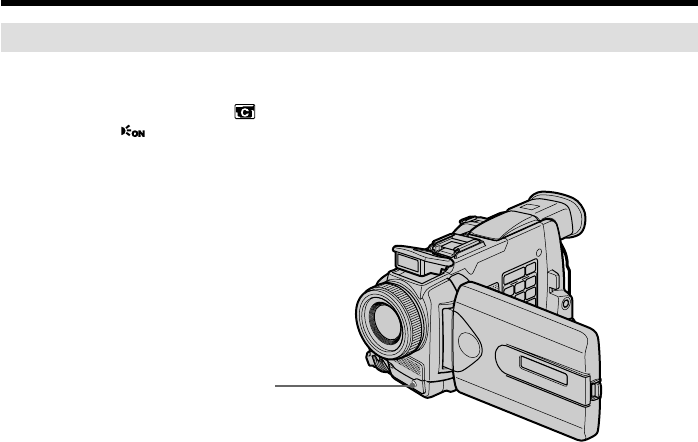
132
Shooting with an auxiliary light – HOLOGRAM AF
The HOLOGRAM AF is an auxiliary light source used for focusing on subjects in dark
places.
Set HOLOGRAM F in to AUTO in the menu settings. (The default setting is AUTO.)
When appears on the screen in a dark place, press PHOTO lightly. Then the
auxiliary light will automatically emit until the subject is focused.
About HOLOGRAM AF
“HOLOGRAM AF (Auto-Focus),” an application of laser holograms, is a new AF
optical system that enables still image shooting in dark places. Having gentler radiation
than conventional high-brightness LEDs or lamps, the system satisfies Laser Class 1 (*)
specification and thus maintains higher safety for human eyes.
No safety problems will be caused by directly looking into the HOLOGRAM AF emitter
at a close range. However, it is not recommended to do so, because you may experience
such effects like several minutes of image residual and dazzling, that you encounter
after looking into a flashlight.
* HOLOGRAM AF satisfies Class 1(time base 30 000 seconds), specified in all of JIS
(Japan), IEC(EU), and FDA(US) industry standards.
Complying with these standards identifies the laser product to be safe, under a
condition that a human looks at the laser light either directly or even through a lens
for 30 000 seconds.
Recording still images on “Memory Stick”s
– Memory Photo recording
HOLOGRAM AF emitter

133
“Memory Stick” Operations
Recording still images on “Memory Stick”s
– Memory Photo recording
Notes
•A conversion lens (optional) may obstruct the HOLOGRAM AF light and make
focusing difficult.
•If enough light does not reach the subject even if the HOLOGRAM AF emitter is
emitted (recommended shooting distance is 2.5 m (8 1/3 feet)), the subject will not be
focused.
•Focusing may be hampered if the light emitted from the HOLOGRAM AF is blocked
by an obstruction.
•Focus is achieved as long as HOLOGRAM AF light reaches to the subject even if its
light is slightly out of the middle position of the subject.
•If HOLOGRAM AF light is dim, it sometimes becomes difficult to focus. If this
happens, wipe the HOLOGRAM AF emitter with a soft, dry cloth.
The HOLOGRAM AF does not emit when:
–Flash is set to No flash
–NightShot is set to ON
–Focusing manually
–Using Spot Focus
–Sunset & moon of PROGRAM AE
–Landscape of PROGRAM AE
–Continuous photo recording
When you use the external flash (optional)
HOLOGRAM AF emits.
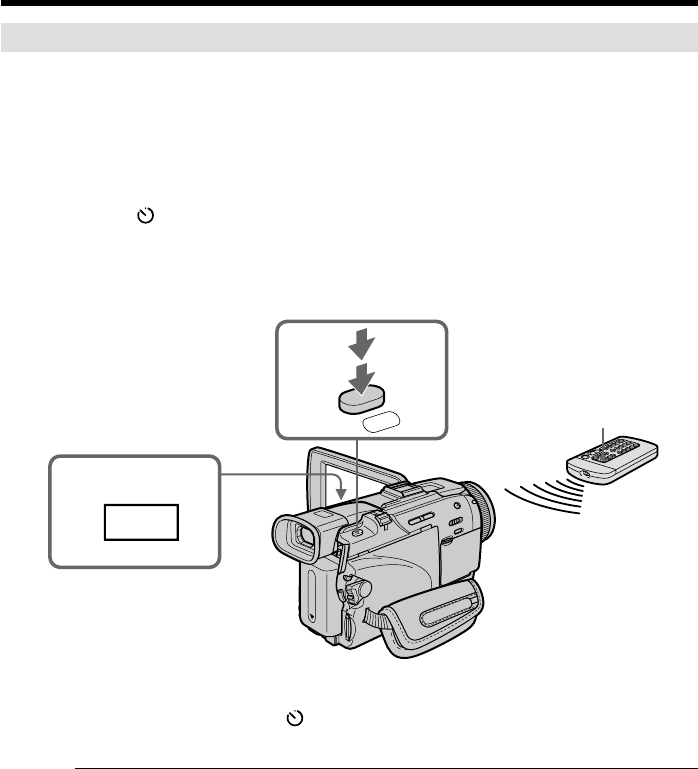
134
Self-timer memory photo recording
You can record images on “Memory Stick”s with the self-timer. You can also use the
Remote Commander for this operation.
(1)Set the POWER switch to MEMORY/NETWORK (DCR-TRV50 only). Make
sure that the LOCK switch is set to the left (unlock) position.
(2)Press FN to display PAGE1.
(3)Press SELFTIMER.
The (self-timer) indicator appears on the screen.
(4)Press PHOTO deeper.
Self-timer starts counting down from 10 with a beep. In the last two seconds of
the countdown, the beep gets faster, then recording starts automatically.
To cancel the self-timer
Press SELFTIMER so that the (self-timer) indicator disappears on the screen. You
cannot cancel self-timer using the Remote Commander.
Note
The self-timer recording is automatically canceled when:
–Self-timer recording is finished.
–The POWER switch is set to OFF (CHG) or VCR.
Recording still images on “Memory Stick”s
– Memory Photo recording
2FN
4
PHOTO
PHOTO
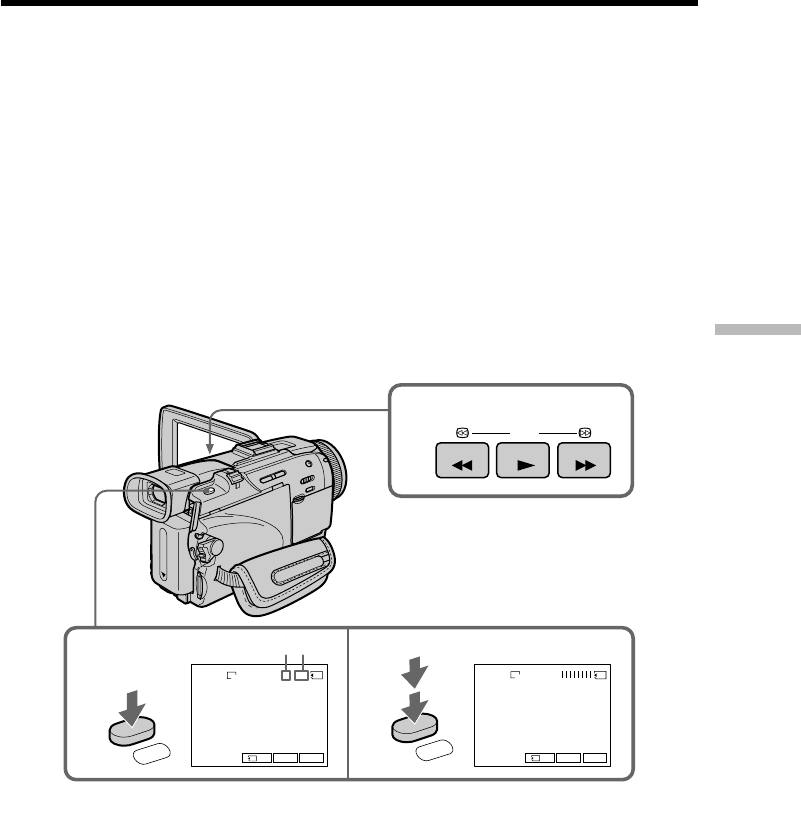
135
“Memory Stick” Operations
Your camcorder can read moving picture data recorded on a tape and record it as a still
image on a “Memory Stick.” Your camcorder can also capture moving picture data
through the input connector and record it as a still image on a “Memory Stick.”
Before operation
•Insert a recorded tape into your camcorder.
•Insert a “Memory Stick” into your camcorder.
(1)Set the POWER switch to VCR.
(2)Press N. Moving pictures recorded on the tape are played back.
(3)Press PHOTO lightly until picture you want to capture from the tape freezes
and CAPTURE appears on the screen. Recording does not start yet.
To change from the image selected to another image, release PHOTO once and
press it lightly again.
(4)Press PHOTO deeper. The image displayed on the screen will be recorded on
the “Memory Stick.” Recording is complete when the bar scroll indicator
disappears.
2
34
CAPTURE
FN
INDEXPB FN
INDEXPB
1 / 12
SFN
640
SFN
640
REW PLAY FF
PHOTO
PHOTO
Recording images from a tape as still
images
[a]: Number of recorded images
[b]: Approximate number of images that can
be recorded on the “Memory Stick”
[a][b]

136
Image size of still images
Image size is automatically set to 640 × 480.
When the access lamp is lit or flashing
Do not shake or strike the unit. Also, do not turn the power off , eject a “Memory Stick.”
Otherwise, image data may become damaged.
If “ ” appears on the screen
The inserted “Memory Stick” is incompatible with your camcorder because its format
does not conform with your camcorder. Check the format of the “Memory Stick.”
If you press PHOTO lightly in the playback
Your camcorder stops momentarily.
Sound recorded on a tape
You cannot record audio from a tape.
Titles already recorded on cassettes
You cannot record titles on “Memory Stick”s. Titles do not appear while you are
recording a still image with PHOTO.
Recording date/time
The recording data (date/time) when it is recorded on a “Memory Stick” is recorded.
Various settings are not recorded.
Data codes recorded on a tape cannot be recorded on a “Memory Stick”.
When you press PHOTO on the Remote Commander
Your camcorder immediately records the image that is on the screen when you press
the button.
Recording images from a tape as still images
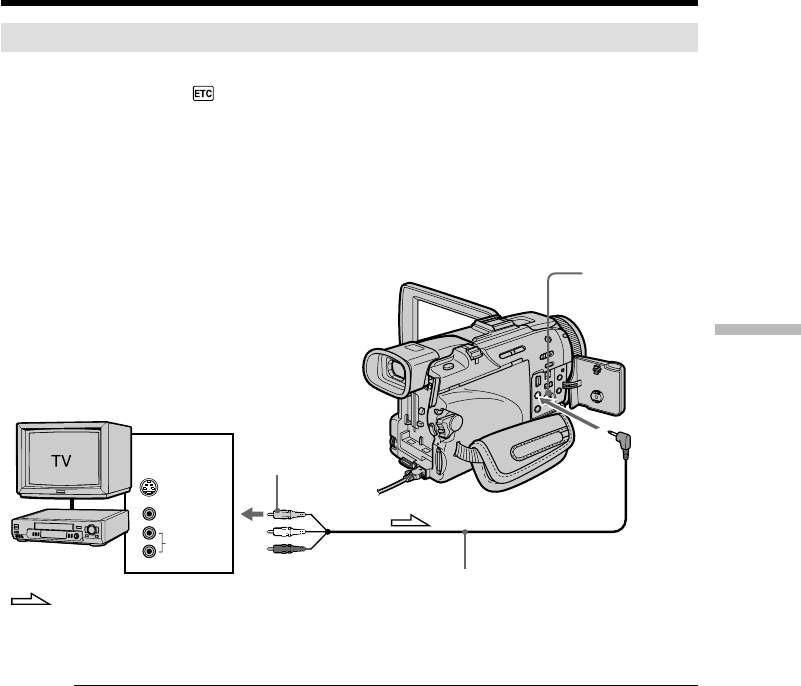
137
“Memory Stick” Operations
Recording images from a tape as still images
Recording a still image from external equipment
Before operation
Set DISPLAY in to LCD in the menu settings. (The default setting is LCD.)
(1)Set the POWER switch to VCR.
(2)Play back the recorded tape, or turn the TV on to see the desired program.
The image of the external equipment is displayed on the screen.
(3)Follow steps 3 and 4 on page 135.
Using the A/V connecting cable
Connect the yellow plug of the A/V connecting cable to the video jack on the VCR or
the TV.
If your TV or VCR has an S video jack
Pictures can be reproduced more faithfully by using an S video cable (optional).
With this connection, you do not need to connect the yellow (video) plug of the A/V
connecting cable.
Connect an S video cable (optional) to the S video jacks of both your camcorder and the
TV or VCR.
AUDIO/
VIDEO
S VIDEO
S VIDEO
VIDEO
OUT
AUDIO
: Signal flow
VCR
Yellow
A/V connecting cable (supplied)
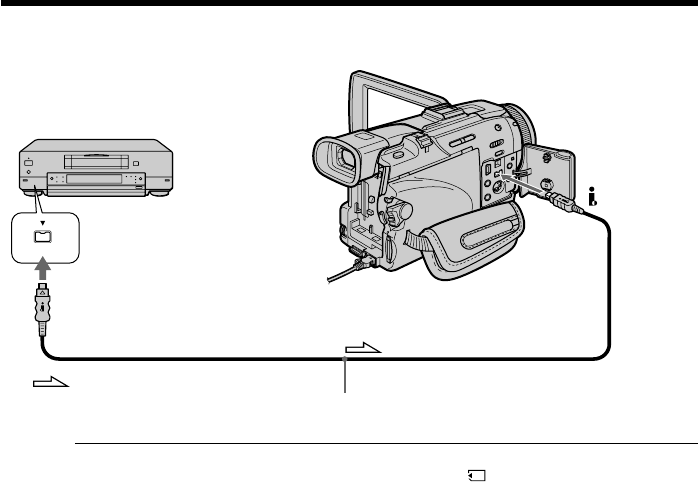
138
Using the i.LINK cable (DV connecting cable)
Note
In the following instances, recording is interrupted or “ REC ERROR” is displayed,
and recording is not possible. Record distortion-free images.
–When recording on a tape in a poor recording state, for example, on a tape that has
been repeatedly used for dubbing
–When attempting to input images that are distorted due to poor radio wave reception
when a TV tuner unit is in use
Recording images from a tape as still images
DV
DV OUT
DV IN/OUT
: Signal flow i.LINK cable (DV connecting cable) (optional)
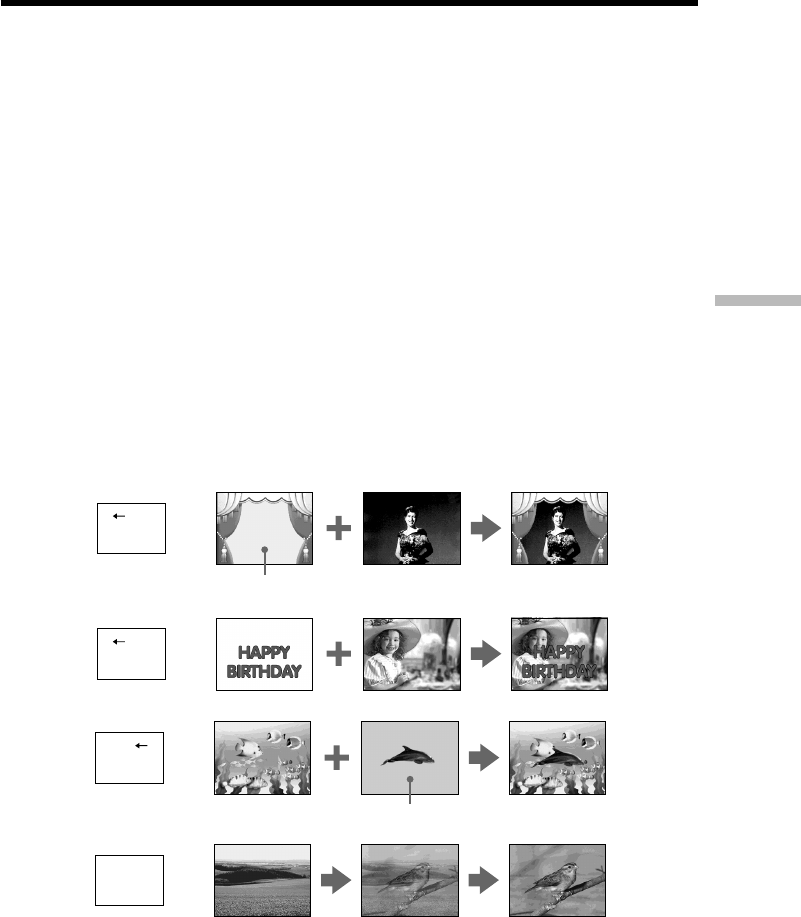
139
“Memory Stick” Operations
You can superimpose a still image you have recorded on the “Memory Stick” on the
moving picture you are recording. You can record the superimposed images on a tape
or a “Memory Stick.” (However, you can record only superimposed still images on the
“Memory Stick.”)
M. CHROM (memory chroma key)
You can swap a blue area of a still image such as an illustration or a frame with a
moving picture.
M. LUMI (memory luminance key)
You can swap a brighter area of a still image such as a handwritten illustration or title
with a moving picture. Record a title on the “Memory Stick” before a trip or event for
convenience.
C. CHROM (camera chroma key)
You can superimpose a moving picture on a still image such as an image that can be
used as background. Shoot the subject against a blue background. The blue area of the
moving picture will be swapped with a still image.
M. OVERLAP* (memory overlap)
You can make a moving picture fade in on top of a still image recorded on the “Memory
Stick” as the overlap.
* The superimposed image using Memory overlap can be recorded on tapes only.
Superimposing a still image in the
“Memory Stick” on an image
– MEMORY MIX
M. CHROM
M C A M
C H R O M
Still image Moving picture
Blue
M. OVERLAP*
Still image Moving picture
C. CHROM
C A M M
C H R O M
Still image Moving picture
Blue
M. LUMI
M C A M
L U M I
Still image Moving picture
O V E R –
L A P

140
Superimposing a still image in the “Memory Stick” on an image
– MEMORY MIX
Recording superimposed images on a tape
Before operation
•Insert a tape for recording into your camcorder.
•Insert a “Memory Stick” recorded still images into your camcorder.
(1)Set the POWER switch to CAMERA.
(2)Press FN to display PAGE1.
(3)Press MEM MIX. The last recorded or last composed image appears on the
lower part of the screen as a thumbnail image.
(4)Press –/+ on the right lower corner of the screen to select the still image which
you want to superimpose.
–: To see the previous image
+: To see the next image
(5)Press a desired mode. The still image is superimposed on the moving picture.
(6)Press –/+ on the left lower corner of the screen to adjust the effect, then press
OK to return to PAGE1.
M. CHROM: Blue chroma key (only blue background portion) to extract a
still image and superimpose it on a moving image
M. LUMI: Brightness level used when extracting a still image and
superimposing it on a moving image
C. CHROM: Blue chroma key (only blue background portion) to extract a
moving picture and superimpose it on a still image
M. OVERLAP: No adjustment necessary
The fewer bars there are on the screen, the stronger the effect.
(7)Press EXIT to return to FN.
(8)Press START/STOP to start recording.
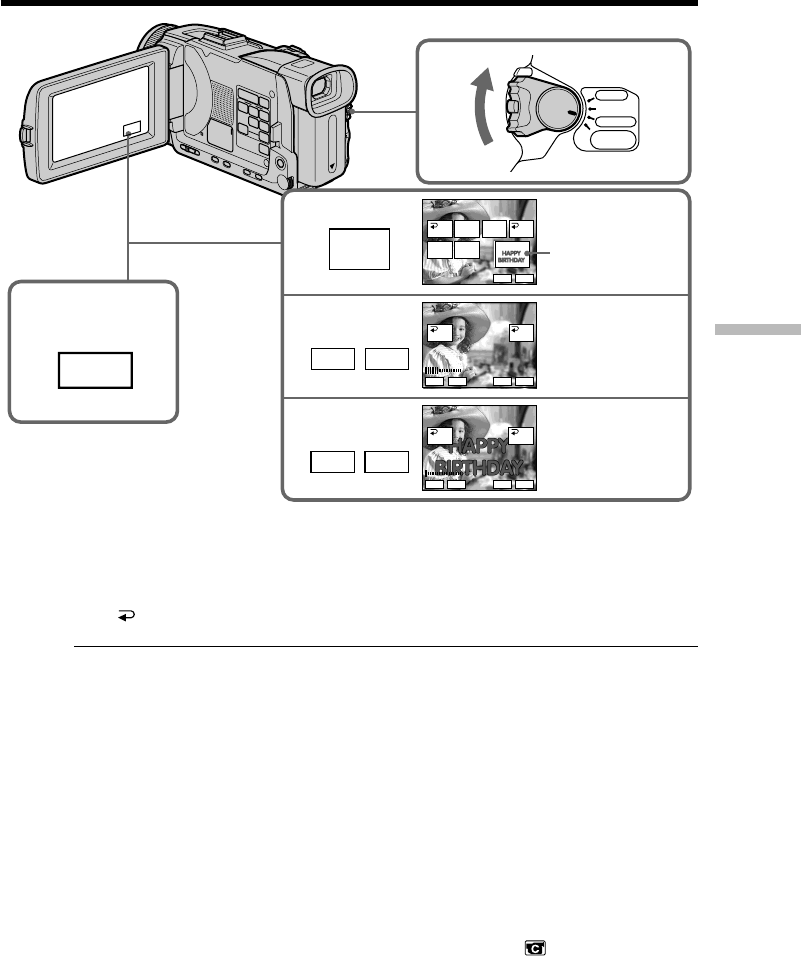
141
“Memory Stick” Operations
Superimposing a still image in the “Memory Stick” on an image
– MEMORY MIX
To change the still image to be superimposed
Press –/+ on the right lower corner before step 6.
To cancel MEMORY MIX
Press OFF to return to PAGE1.
Notes
•You cannot use the MEMORY MIX for moving pictures recorded on “Memory Stick”s.
•When the overlapping still image has a large amount of white, the thumbnail image of
the picture may not be clear.
Image data modified on your computer or shot with other equipment
You may not be able to play back modified images with your camcorder.
When you select M. OVERLAP
You cannot change the still image or the mode setting.
During recording
You cannot change the mode setting.
To record the superimposed image as a still image
Press PHOTO deeper in step 8 (You should set PHOTO REC in to TAPE in the
menu settings beforehand).
3,4
5
6
FN
MEM
M
I
X
+–
+–
2
1
100–0001
+–
MEM MIX
MCCAM
LUMI OVER-
LAP
OFF OK
MCCAM
CHROM
CAMCM
CHROM
M. LUMI
100–0001
+–
MEM MIX
OFF OK
+–
M. LUMI
100–0001
+–
MEM MIX
OFF OK
+–
VCR
MEMORY/
NETWORK
CAMERA
OFF(CHG)
POWER
Still image

142
Recording superimposed images on a “Memory Stick” as a still
image
Before operation
Insert a “Memory Stick” recorded still images into your camcorder.
(1)Set the POWER switch to MEMORY/NETWORK (DCR-TRV50 only). Make
sure that the LOCK switch is set to the left (unlock) position.
(2)Press FN and select PAGE2.
(3)Press MEM MIX. The last recorded or last composed image appears on the
lower part of the screen as a thumbnail image.
(4)Press –/+ on the right lower corner of the screen to select the still image which
you want to superimpose.
–: To see the previous image
+: To see the next image
(5)Press a desired mode. The still image is superimposed on the moving picture.
(6)Press –/+ on the left lower corner of the screen to adjust the effect, then press
OK to return to PAGE2.
M. CHROM: Blue chroma key (only blue background portion) to extract a
still image and superimpose it on a moving image
M. LUMI: Brightness level used when extracting a still image and
superimposing it on a moving image
C. CHROM: Blue chroma key (only blue background portion) to extract a
moving picture and superimpose it on a still image
The fewer bars there are on the screen, the stronger the effect.
(7)Press EXIT to return to FN.
(8)Press PHOTO deeper to start recording.
The image displayed on the screen will be recorded on a “Memory Stick.”
Recording is complete when the bar scroll indicator disappears.
Superimposing a still image in the “Memory Stick” on an image
– MEMORY MIX
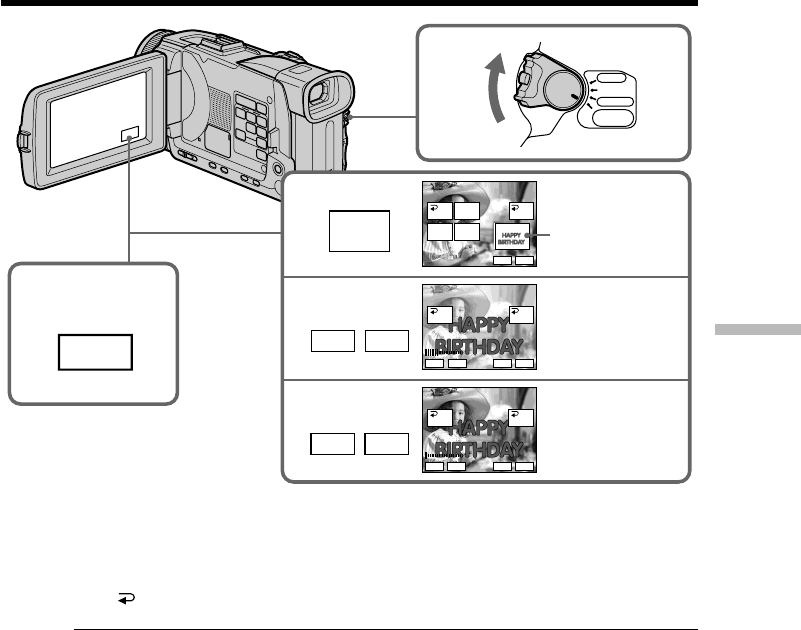
143
“Memory Stick” Operations
Superimposing a still image in the “Memory Stick” on an image
– MEMORY MIX
To change the still image to be superimposed
Press –/+ on the right lower corner before step 6.
To cancel MEMORY MIX
Press OFF to return to PAGE2.
Notes
•You cannot use MEMORY MIX for moving pictures recorded on “Memory Stick”s.
•When the overlapping still image has a large amount of white, the thumbnail image of
the picture may not be clear.
Image size of still pictures
Image size is automatically set to 640 × 480.
Image data modified with your computers or shot with other equipment
You may not be able to play back modified images with your camcorder.
During recording
You cannot change the mode setting.
When recording images on a “Memory Stick” using the MEMORY MIX
The PROGRAM AE does not work. (The indicator flashes.)
The “Memory Stick” supplied with your camcorder stores 20 images
–For M. CHROM: 18 images (such as a frame) 100-0001~100-0018
–For C. CHROM: two images (such as a background) 100-0019~100-0020
Sample images
Sample images stored in the “Memory Stick” supplied with your camcorder are
protected (p. 167).
3,4
5
6
FN
MEM
M
I
X
+–
+–
VCR
MEMORY/
NETWORK
CAMERA
OFF(CHG)
POWER
2
1
100–0001
+–
MEM MIX
MCCAM
LUMI
OFF OK
MCCAM
CHROM
CAMCM
CHROM
M. LUMI
100–0001
+–
MEM MIX
OFF OK
+–
M. LUMI
100–0001
+–
MEM MIX
OFF OK
+–
Still image
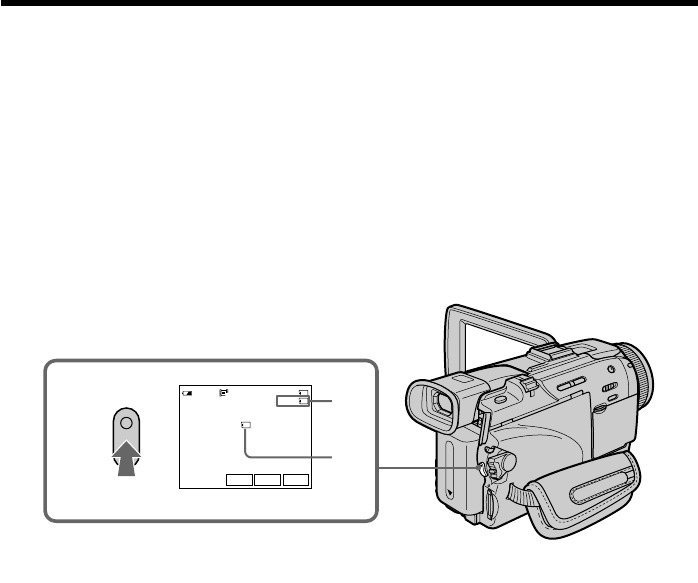
144
You can record moving pictures with sound on “Memory Stick”s.
The picture and sound and recorded up to the capacity of “Memory Stick” (MPEG
MOVIE EX).
Before operation
Insert a “Memory Stick” into your camcorder.
(1)Set the POWER switch to MEMORY/NETWORK (DCR-TRV50 only). Make
sure that the LOCK switch is set to the left (unlock) position.
(2)Press START/STOP. Your camcorder starts recording. The camera recording
lamp located on the front of your camcorder lights up. The picture and sound
are recorded up to the remaining capacity of “Memory Stick”. For more
information about recording time, see page 125.
To stop recording
Press START/STOP.
Recording moving pictures on “Memory
Stick”s – MPEG movie recording
2
320
40min REC 0:00:03
15
min
BBB
FN
INDEXPLAY
[a]
[b]
[a]: Recording time that can be recorded on
the “Memory Stick”.
[a] [b]: These indicators are displayed for five
seconds after pressing START/STOP.
This indicator is not recorded.

145
“Memory Stick” Operations
Note
Sound is recorded in monaural.
When the POWER switch is set to MEMORY/NETWORK (DCR-TRV50 only)
The following functions do not work:
–Wide mode
–Digital zoom
–SteadyShot
–Super NightShot
–Color Slow Shutter
–Fader
–Picture effect
–Digital effect
–Title
–Sports lesson of PROGRAM AE (The indicator flashes.)
When using an external flash (optional)
Turn the power of the external flash off when recording moving pictures on “Memory
Stick”s. Otherwise, the charging sound for the flash may be recorded.
Recording date/time
The date/time are not displayed while recording. However, they are automatically
recorded onto the “Memory Stick.”
To display the recording date/time, press DATA CODE during playback. You can also
use the Remote Commander for this operation (p. 42). Various settings cannot be
recorded.
During recording on “Memory Stick”
Do not eject the cassette tape from your camcorder. During ejecting the tape, sound is
recorded on the “Memory Stick.”
When the POWER switch is set to MEMORY/NETWORK (DCR-TRV50 only)
The angle of view is slightly larger compared with the angle of view when the POWER
switch is set to CAMERA.
Recording moving pictures on “Memory Stick”s
– MPEG movie recording
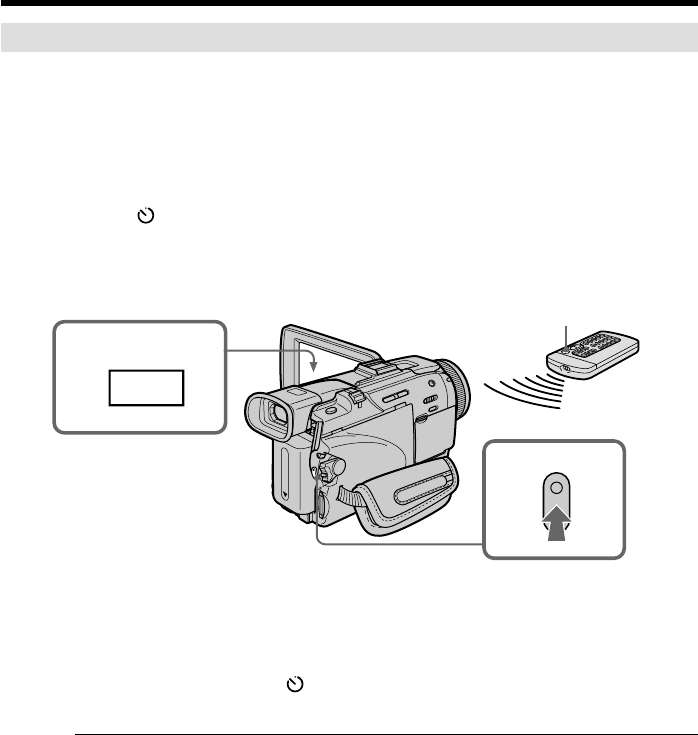
146
Self-timer MPEG movie recording
You can record moving pictures on “Memory Stick”s with the self-timer. You can also
use the Remote Commander for this operation.
(1)Set the POWER switch to MEMORY/NETWORK (DCR-TRV50 only). Make
sure that the LOCK switch is set to the left (unlock) position.
(2)Press FN to display PAGE1.
(3)Press SELFTIMER.
The (self-timer) indicator appears on the screen.
(4)Press START/STOP.
Self-timer starts counting down from 10 with a beep. In the last two seconds of
the countdown, the beep gets faster, then recording starts automatically.
To stop the countdown
Press START/STOP. To restart the self-timer, press START/STOP again.
To cancel the self-timer
Press SELFTIMER so that the (self-timer) indicator disappears on the screen. You
cannot cancel self-timer using the Remote Commander.
Note
The self-timer recording is automatically canceled when:
–Self-timer recording is finished.
–The POWER switch is set to OFF (CHG) or VCR.
Recording moving pictures on “Memory Stick”s
– MPEG movie recording
2
FN
4
START/STOP
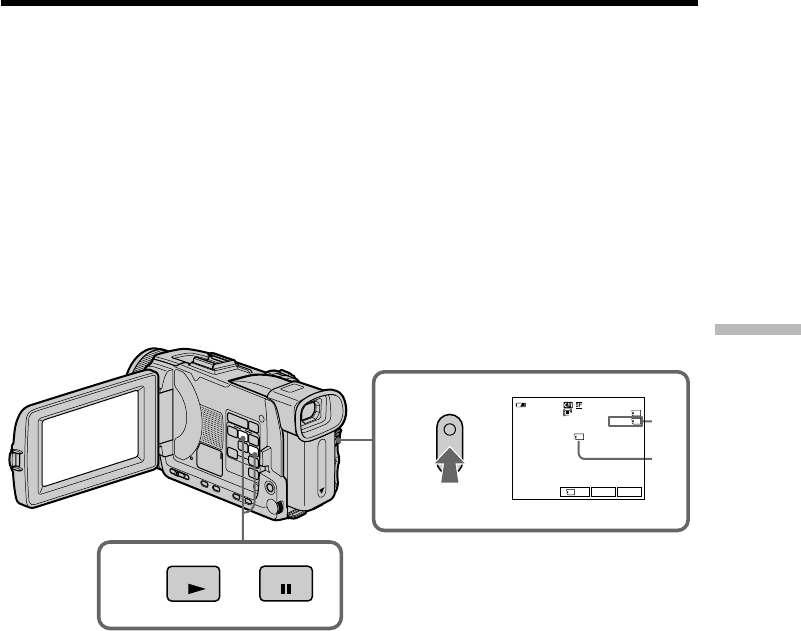
147
“Memory Stick” Operations
Your camcorder can read moving picture data recorded on a tape and record it as a
moving picture on a “Memory Stick.” Your camcorder can also capture moving picture
data through the input connector and record it as a moving picture on a “Memory
Stick.”
Before operation
•Insert a recorded tape into your camcorder.
•Insert a “Memory Stick” into your camcorder.
(1)Set the POWER switch to VCR.
(2)Press N. The picture recorded on the tape is played back.
And press X at the scene where you want to start recording from.
(3)Press START/STOP on your camcorder. The picture and sound are recorded
up to the remaining capacity of the “Memory Stick”. For more information
about recording time, see page 125.
To stop recording
Press START/STOP.
Recording pictures from tape as a moving
picture
3
2
320
BBB
N
40min REC 0:00:03
15
min
0:15:42:43
PLAY PAUSE
FN
INDEXPB
[a]: The recording time that can be
recorded on the “Memory Stick.”
[a] [b]: This indicator is displayed for
five seconds after pressing START/
STOP. This indicator is not recorded.
[a]
[b]

148
Notes
•Sound recorded in 48 kHz is converted to 32 kHz sound when recording images from
a tape to “Memory Stick”s.
•Sound recorded in stereo is converted to monaural sound when recording from tape.
When the access lamp is lit or flashing
Do not shake or knock the unit. Also, do not turn the power off , eject a “Memory
Stick”. Otherwise, image data may become damaged.
Titles already recorded on cassettes
You cannot record titles on “Memory Stick”s. Titles do not appear while you are
recording moving picture with START/STOP.
If “ AUDIO ERROR” is displayed
Sound that cannot be recorded by your camcorder has been recorded. Connect the A/V
connecting cable to input images from external equipment used to play back the image
(p. 149).
Recording date/time
The recording data (date/time) when it is recorded on “Memory Stick” is recorded.
Various settings are not recorded.
Data codes recorded on a tape cannot be recorded on a “Memory Stick”.
Recording pictures from tape as a moving picture
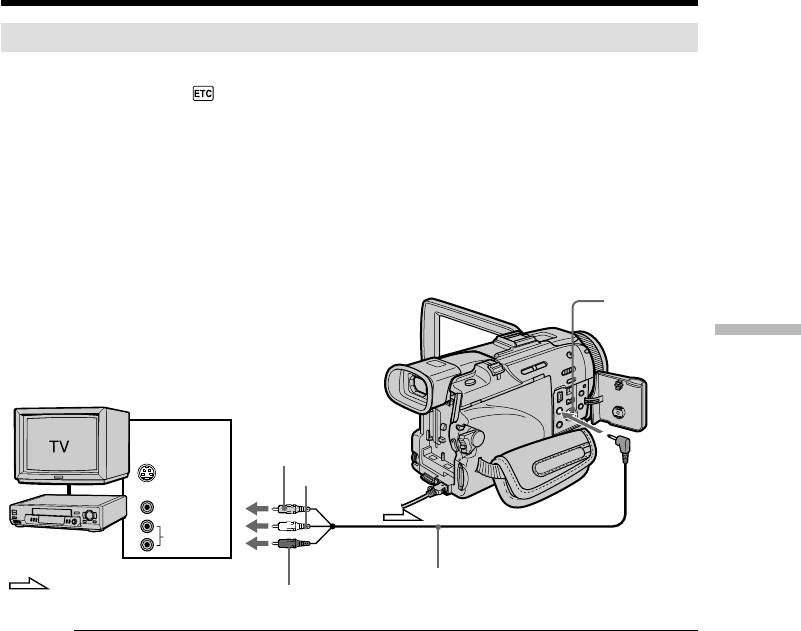
149
“Memory Stick” Operations
Recording a moving picture from external equipment
Before operation
Set DISPLAY in to LCD in the menu settings. (The default setting is LCD.)
(1)Set the POWER switch to VCR.
(2)Play back the recorded tape, or turn the TV on to see the desired program.
The image of the other equipment is displayed on the screen.
(3)Follow the procedure on page 147 from the step 3 onwards at the point where
you want to start recording from.
Using the A/V connecting cable
If your TV or VCR has an S video jack
Pictures can be reproduced more faithfully by using an S video cable (optional).
With this connection, you do not need to connect the yellow (video) plug of the A/V
connecting cable.
Connect an S video cable (optional) to the S video jacks of both your camcorder and the
TV or VCR.
Recording pictures from tape as a moving picture
S VIDEO
VIDEO
OUT AUDIO/
VIDEO
S VIDEO
AUDIO
: Signal flow
VCR
Yellow
White
A/V connecting cable (supplied)
Red
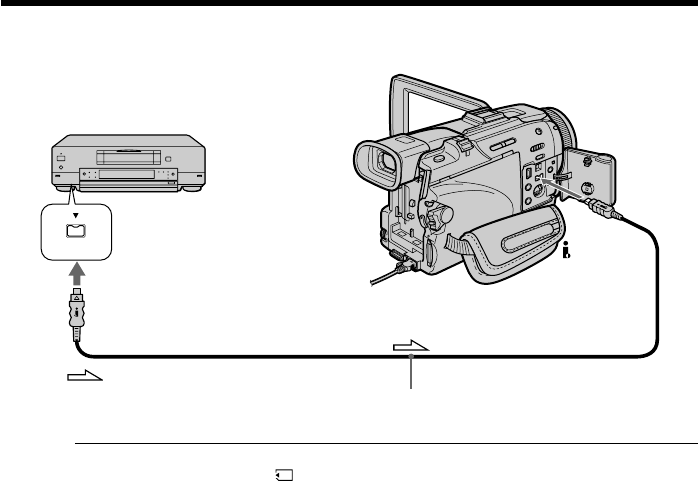
150
Using the i.LINK cable (DV connecting cable)
Note
In the following instances, “ REC ERROR” is displayed and you cannot record
pictures.
–When recording on a tape in a poor recording state, for example, on a tape that has
been repeatedly used for dubbing
–When attempting to input images that are distorted due to poor radio wave reception
when a TV tuner unit is in use
– When the input signal is cut off
During recording on “Memory Stick”
Do not eject the cassette tape from your camcorder.
Recording pictures from tape as a moving picture
DV OUT
DV IN/OUT
DV
: Signal flow i.LINK cable (DV connecting cable) (optional)